

Tradescantia fluminensis Lilac
Tradescantia fluminensis Lilac grow and care – herbaceous of the genus Tradescantia also known as Wandering gypsy or Lilach Wandering jew plant , Tradescantia fluminensis Lilac perennial evergreen or annual in colder climate used as ornamental groundcover plant, can grow in mediterranean, desert, subtropics, temperate or tropics climate and growing in hardiness zone 9b+ as perennial and hardiness zone 3+ as annual plant and with the right care in hardiness zone 9a.
Tradescantia fluminensis Lilac leaves and flowers
Leaves color green, white and purple, in elliptic shape with pointed edge.
Flower color white, triangle shape flower that assembled by 3 triangle petals.
Tradescantia fluminensis Lilac for sale – Seeds or Plants to Buy
Buy Now in E-bay
How to grow Tradescantia fluminensis Lilac growing and care:
Strong plant without special requirement but the plant prefer: moist soil, humidity, rich soil, space to crawl
How to care : When the plant young to add mulch to keep the moist of the soil, pruning once a year better after blooming season, add once a year organic matter
What is the best way to start growing? Plant / Seedling / Seed / Vegetative Reproduction – propagate by cutting or bending a branch over and covering it with soil
How to propagate by cutting: Propagate by cuttings – cut stem and better to cut stem with at least 3 leaves, put it in the soil keep the soil moist and high humidity, cutting season spring to early summer another option cuttings in water need to switch every few days the water and after grow few roots to put in the soil or to wait more and put fertilizer
Is it necessary to graft or use vegetative reproduction? No, but easier start from cutting than to start by seeds although germination also easy and when grow as annual better to start by cutting
Difficulties or problems when growing: Invasive, aggressive
Planting season: Spring as annual plant or in hardiness zone 9, spring to summer in hardiness zone 10a, spring to autumn 10b-11a, all year in hardiness zone 11b+
Pests and diseases: Aphids, mealy bug
Pruning season: All year, better in the winter and after blooming season
How to prune: Dead leaves and bloom stems
Size of the plant: 20-50 cm, 8-20 inches
Growth speed in optimal condition: Fast growing / Medium growing
Water requirement: Average amount of water to small amount of water and can be drought tolerant
Light requirements and conditions in optimal condition for growing: Full sun, half shade, full shade – possible but need to know that without enough light the plants won’t bloom the plant need a lot of hours of indirect sunlight
Is it possible to grow indoor as houseplant? Yes, but in order to bloom need to be mature and that mean place to grow
How to grow indoors Choose location with light (better with even with little sun), artificial home light won’t be enough and indirect light will do the job
Growing is also possible in a pots, planter, flowerpot, containers: Yes, start with container size minimum 5L to 10L (2.6-5.2 gallons) better bigger than the root ball at least 200% (the plant grow very fast), every time that the roots fill the pot need to switch to bigger or to prune the roots and the leaves and re-plant it also better to switch the soil every few years, better to use potting mix or peat soil with perlite, mix it with humus and organic matter, use chopped mulch to keep the soil moist, let the bottom of the pot fill in water but dry once in a few day.
Blooming information
Bloom season: Spring / Summer
General information about the flower: Triangle shape flower that assembled by 3 triangle petals, flower color white
How to grow Tradescantia fluminensis Lilac from seeds
Sowing requirement: Sunny location with good drainage
Saving seeds and care until sowing: Dry and dark place, better to keep in in the refrigerate before
Sowing season: Spring to summer
How to plant: Plant in light soil with good drainage
Planting spacing: 20*30cm (8*12 inches)
Depth of Sowing: 0.5-1cm (0.25-0.5inches)
Conditions for seeds germinate: Moist soil with light humidity
Watering requires for Seeds: Average amount of water, keep soil moist but not over water and don’t let it dry
Germination time: 2-8 weeks
Condition of seedling: Full sun, regularly water, keep the soil moist
Scientific name:
Tradescantia fluminensis

- Indoor Gardening
- Houseplants
- Hydroponics
- Houseplants Made Easy Book

How To Care For A Wandering Jew Plant (Your Complete Guide)
When it comes to houseplants able to brighten up indoor spaces, it doesn’t get much more colorful than the variegated foliage of a Wandering Jew plant ( Tradescantia zebrina ). With their hardy nature and ease of care, they are a perfect choice for those feeling they kill everything they bring indoors. We’ve listed a quick summary of their care below.
How To Care For A Wandering Jew Plant: Grow your Wandering Jew in well-drained soil, kept moist but not soggy through regular watering. Create humidity, keep indoor temperatures between 50°F (10°C) to 85°F (29°C) and fertilize monthly.
Continue reading because we’ve taken all the guesswork out of caring for your Wandering Jew and keeping it healthy and happy for years to come.
How To Care For A Wandering Jew Plant
Wandering Jew plants belong in the Commelinaceae family, which includes around 652 different species. The family is made up of herbs, climbers and several epiphytes, with some used as outdoor and indoor ornamentals like Wandering Jew.
There are three different plants commonly known as Wandering Jews; Tradescantia fluminensis , Tradescantia pallida , and Tradescantia zebrina. Of the three, Tradescantia zebrina is the most common one grown and has the most eye-catching and colorful foliage. All three have the same requirements for care and good growth.
Native to Mexico and Guatemala, Wandering Jew is classified as a tender evergreen perennial that performs well planted outdoors in frost-free regions. Those living in cooler environments can easily grow it as an indoor plant planted either in containers or in hanging baskets. Outdoors it’s typically used as a quick-growing groundcover.
Although a common name shared with several very different plants, Wandering Jew is often called Inch Plant , due to the leaf margins being spaced about an inch apart. You may also find Wandering Jew listed as Zebrina Pendula , but is synonymous with Tradescantia zebrina and is the same plant.

When it comes to Wandering Jew plants, it’s all about the attention-grabbing foliage. The succulent stems give way to leaves that are a deep purple on their undersides with the upper portion striped in silvery-gray and greenish-blue. The oval leaves grow to about 2.5 inches long and the stems grow about 2 feet long. It makes a beautiful plant used in hanging baskets, with the long stems cascading over the side.
Even grown indoors, Wandering Jews have a fast rate of growth and before you know it, the plants will be spilling over your container’s or hanging basket’s sides. Whereas some indoor plants seem to take forever to fill out, this isn’t a problem with properly cared for Wandering Jew plants.
There are several other cultivars (varieties) of Wandering Jew, which include:
- ‘Purpusii’ has unstriped, hairy foliage that is either solid red or reddish-green.
- ‘Quadricolor’ produces metallic-green foliage striped in red, white and green.
Wandering Jew plants are the ideal candidates for beginner houseplant gardeners due to their hardiness and robust growth. Below we’ve outlined all the basics of their proper care, as well as identifying and preventing any potential problems so you can enjoy your Wandering Jew for years to come. The best indoor plants are those that are happy and healthy.

Soil Conditions For Wandering Jew Plants
Wandering Jew plants tolerate growing in a wide range of soils provided they drain well. Although they do tolerate and prefer moist conditions, the soil must drain properly to prevent root and stem rot from occurring. Therefore, it is necessary to use a lighter weight soil mixture in your pots rather than heavier soils that don’t provide proper drainage.
Straight potting soils are usually too heavy, retain too much moisture and have a tendency to leave the soil soggy. You can use a heavier potting soil in your soil mixture, just be sure to incorporate a lighter soil mix to provide the Wandering Jew the drainage required for healthy growth.
Commercial potting mixes work well and many have a slow-release fertilizer mixed in, which cuts down on the need for frequent feedings. The slow-release blends usually continue to fertilize the Wandering Jew for about three months.
You can also make your own soil by mixing several ingredients together such as:
- Using equal parts of compost and a potting mix.
- Mixing equal portions of compost, peat and potting soil or a potting mix.
- Using equal portions of a course sand, compost and potting soil or a potting mix.
Whatever soil you choose to use, just make sure it drains well and contains a bit of fertility for the best performance of your Wandering Jew plants.
Preferred Light Conditions
Although Wandering Jew plants tolerate lower light conditions than many houseplants, to help retain those striking colors the plant is known for, place the container in a location indoors receiving filtered sunlight. If your plant starts losing some of the color in the foliage, move it to a location that receives a bit more light.
In addition, if the lower portion of the stems start suffering leaf drop, the Wandering Jew isn’t get enough light and needs to be relocated to a brighter area inside the home.
Once the warm weather of spring arrives and if you’d like to give your Wandering Jew a bit of a break from its indoor location, place it in an outdoor spot that receives partial sun to partial shade. Moving it to an outdoor location with too much sun may leave the foliage sunburned.
Indoor Temperature Requirements
In the Wandering Jew’s native environment, temperatures are consistently warm without the threat of frosts or freezes. Generally, if the indoor temperatures inside your home are comfortable for you, they will also be comfortable for your Wandering Jew plant.
Indoor temperatures between 50°F (10°C) to 85°F (29°C) are a good range for your Wandering Jew plants. Plants grown in this temperature range produce the healthiest growth.
If you gave your plants a break from their indoor location, just make sure to bring them back indoors before the cold weather of winter strikes.
Water Requirements
Wandering Jews prefer soils that are regularly kept moist, not soggy, compared to many indoor houseplants. However, this doesn’t mean the soil should be kept so wet they never begin to dry out. Keeping the soil too wet for too long promotes rot to set in and you may end up killing your Wandering Jew plants. Your Wandering Jew is more likely to forgive you if you forget to water over watering too much and too often.
A good rule to follow is if the soil starts to feel like it’s about to become very dry, apply water. It’s easy to know exactly when to water by:
- Sticking your finger into the soil and if the top inch is starting to feel dry, water until it runs from the container’s bottom drain holes.
During the warm growing season of spring through summer, you can probably expect to water once each week. However, during winter when the Wandering Jew goes into dormancy (its growth slows), you will probably only need to water about every other week.

Humidity Requirements
Compared to many tropical plants grown indoors, Wandering Jew plants aren’t quite as fussy about humid conditions , but still need some humidity for the best growth and performance. Don’t let the thought of creating a humid environment stress you out because replicating humidity for your indoor plants is relatively easy and basic.
- Fill a spray bottle with room temperature water and mist the Wandering Jew several times each week.
- If you’re growing the Wandering Jew in a container and not in a hanging basket, you can set the pot on a tray of pebbles. As you water, the water seeps from the bottom drain holes onto the tray of pebbles and as it evaporates, it creates a humid environment around the plant.
- If your bathroom gets the appropriate amount of light for the Wandering Jew, you can allow it to grow there. Due to the regular use of water in a bathroom, moisture is created, creating the humidity the Wandering Jew requires.
Fertilizer Needs
Unless the soil mixture contains a slow-release fertilizer blend, which feeds the Wandering Jew for about three months, fertilizing monthly is sufficient for proper growth. You have several choices when it comes to fertilizer you can use for your Wandering Jew plant.
- Use a houseplant fertilizer applied at half-strength, applied when you do your regular watering.
- Use an all-purpose, water-soluble blend for outdoor and indoor plants, applied at half-strength and used during your regular watering schedule.
- If your soil mixture didn’t contain a slow-release fertilizer or it’s been about three months, if one was contained in the soil, you can reapply slow-release fertilizer granules sprinkled over the top of the soil. Follow the package directions on amounts.
When it comes to the appropriate time of year to fertilize the Wandering Jew, only fertilize while it’s actively growing, which is spring throughout summer. In winter, the plant goes through a dormant stage and all growth slows, so there is no need to apply fertilizer. Wait until spring arrives before you resume fertilizing the plant.
The one thing you will need to pay attention to when it comes to fertilizing is the buildup of salts in the soil, which can result in foliage burns. Wandering Jew plants have a low tolerance to salty soils. Preventing any salt buildup is relatively simple:
- If the plant isn’t too big, you can take the entire pot to your sink or bathtub and allow water to run slowly through the soil for about five minutes, flushing out any salts.
- If the plant is too big for indoor flushing, take it outside and allow water from the hose to run slowly through the soil for about five minutes. Allow the water to drain and then bring the plant back indoors.
Pruning Requirements
The pruning needs of Wandering Jew plants are low. If you want to control the size of the plant and promote bushier growth, you can pinch off the tips of the stems. To keep the plant always looking its best, you can trim off any broken, dead or damaged stems and leaves throughout the year.
When using pruning tools to trim your Wandering Jew always make sure they are clean so you don’t transfer any diseases or pests to your plant. This is as easy as wiping off the blades with alcohol.
Some people experience skin irritations when handling the cuttings due to the sap , so if you are unsure if you are one of these unlucky gardeners, it might be best to wear gardening gloves when pruning or handling Wandering Jew cuttings.
Potting Needs
If you purchased your Wandering Jew already potted in a hanging basket or 1-gallon container, it should thrive as is for a year or more before it requires repotting. However, if you received rooted cuttings in smaller containers like 4- to 6-inch pots, you most likely need to repot them into something a bit larger so they can grow properly.
This also cuts down on the need for repotting in a month or two as the Wandering Jew begins to outgrow its present pot.
When it comes to the pot’s material, any type works quite well for growing this plant from clay to plastic. However, if you grow your Wandering Jew in a pot made of a porous material like terra cotta, the soil is going to dry quicker than if it was growing in a plastic pot. This means you will need to water more frequently.
Once your Wandering Jew starts getting too big for its present container, it’s time to repot it into one that is around 1- to 2-inches larger. Although the plant likes a moist soil, make sure the pot has bottom drainage to prevent the possibility of rot due to conditions that are too wet.
If you like, you can dress the container up by placing the draining one inside a decorative pot without bottom drain holes, but be sure to empty out any additional water once the inner pot thoroughly drains.
I think a decorative outer pot can add so much to the beauty of your houseplants, so I do this with almost all of my houseplants. Read this article which discusses my favorite decorative planters if you need some inspiration.
Potting and repotting your Wandering Jew is basic:
- Gently remove the Wandering Jew from its present container, being careful not to break the succulent stems.
- Fill the new container that drains about a quarter of the way full with a fertile, well-drained potting mix.
- Check the Wandering Jew’s root system and if it’s growing bunched together and filled the previous pot, gently tease the roots apart with your hands.
- Place the Wandering Jew into the new container and finish filling it with soil.
- Water the Wandering Jew until it runs from the bottom drain holes and place in a bright location indoors.

Propagating New Plants
When it comes to propagating new plants, Wandering Jew is about as easy as it gets. Even if you have never done this before you should have success starting its cuttings. When you trim to control its size, don’t throw those cuttings away but use them to start additional plants.
You have two choices when it comes to rooting your cuttings and both are easy. The first thing you will want to do is obtain your cuttings. Trim off a 4- to 6-inch cutting from the mother plant and you’re ready to start rooting.
Rooting in Soil
- Fill a 6-inch to 1-gallon container that drains with a rich, well-drained potting mix. Water the soil to settle it.
- Make about a 2-inch indentation in the soil where you want to place the Wandering Jew cutting.
- Remove the bottom leaves from the cutting where you will be inserting it into the soil. You can do this by pinching them off with your fingers.
- Place the cutting into the indentation and firm the soil up around it with your fingers.
- Water the soil again and place the cutting in the same light conditions where the mother plant was thriving. Keep the soil moist but not soggy.
Roots should form in about four weeks and after about eight weeks, the Wandering Jew cuttings should form a new root system.
Rooting in Water
- Fill a glass jar or plastic container with about 3-inches of room temperature water.
- Pinch off any leaves from the section of the Wandering Jew cutting that will be submerged in the water.
- Place the cutting in the water and situate the container in a bright indoor location.
- Change the water in the container about every other week, or when cloudy.
You should start seeing new roots form on the cuttings in several weeks. Once the roots are several inches long, you can repot the cuttings into a draining container filled with fertile, well-drained soil.
Disease Problems
Wandering Jew plants grown indoors are hardy and don’t have major diseases that plague them. However, rot is their biggest enemy and caused by soils that are too heavy and do not drain properly, retaining too much water. Overwatering and planting in pots that don’t drain are other causes of rot problems.
When rot rears its ugly head you’ll notice the bottom stems, as well as the foliage turning black, becoming mushy and the entire plant collapses. If this happens and seems to start affecting the entire Wandering Jew plant, you can trim off healthy, unaffected sections of the stems and repot into fresh, clean soil. Since there is no saving the rot-infected sections, you will have no choice but to discard those portions of the plant.
Steps for preventing problems with rot include:
- Using lightweight potting mixes that drain well and aren’t too heavy, which leads to the soil remaining too wet for too long. Some types of potting soils have a tendency to be heavy and need mixing with a potting mix, compost, coarse sand or peat.
- Don’t overwater your Wandering Jew. Although they prefer growing in moist soils, this doesn’t mean constantly soggy soil. Stick your finger into the soil and if the top inch is starting to become dry, apply water until it runs from the bottom of the pot.
- Make sure the pot you are growing your Wandering Jew in has bottom drainage. If you have placed the pot inside a decorative one that doesn’t drain, make sure to empty all the water from it after you have watered.
Pest Problems
Although indoor Wandering Jew plants are not big candidates for problems with pests, several can cause an infestation and problems. As with any pest problem indoors or outside in the garden, quick control is always the best option to keep your plants healthy. It also assures the pests do not migrate to your other plants causing even bigger problems and headaches.
The pests most likely to infest your indoor Wandering Jew plants are:
- Aphids: Aphids come in a host of different colors and are tiny, pear-shaped, sap-sucking insects that usually congregate in large masses along the Wandering Jew’s stems. In large infestations, they can kill the plant or severely weaken it. If the infestation is small, you can wipe the pests off the stems with a moist cloth. However, if the infestation is large, you will probably have to spray the plant with an insecticidal soap or Neem, reapplying as suggested on the package.
- Spider Mites: Spider mites are another sap-sucking pest that if left unchecked can quickly kill or weaken the Wandering Jew. It is easy to tell if you have a spider mite problem as these tiny, white pests spin fine webbing that covers the plant. Spider mites can be the bane of houseplants so quick control is necessary. Use an insecticidal soap or Neem and spray the entire plant, reapplying as suggested on the product label.
- Whiteflies: Whiteflies are other sap-sucking pests that can quickly kill or weaken your Wandering Jew if not quickly controlled. They are another easily identifiable pest, as just touching the plant sends the tiny whiteflies from the plant’s foliage and into the air, hovering right above it. Control the problem with an insecticidal soap or Neem, spraying the entire plant and reapplying as suggested on the product’s label.
- Mealybugs: Sap-sucking mealybugs show up on the Wandering Jew as cottony masses covering the stems and crotches of the foliage. Control the problem by spraying the entire plant with insecticidal soap or Neem, reapplying as suggested on the product’s label. If the infestation is small, you can also wipe them from the stems and leaves with a damp cloth.

Is Wandering Jew A Perennial?
Wandering Jew plants are considered a tender, evergreen perennial. Unlike annuals, and if grown in preferred conditions with proper care, Wandering Jews should live and keep on growing for quite a few years, both indoors and outside.
Why Are My Wandering Jew Plant’s Leaves Losing Their Color?
If your Wandering Jew is growing in light conditions that are too low, the leaves will start to lose their color and become duller. When grown indoors and to keep the bright color on the foliage, make sure the Wandering Jew is growing in a location receiving bright light.
Why Are My Wandering Jew’s Leaves Dropping?
Wandering Jew plants grown in light conditions that are too low will start dropping leaves at the base of their stems. Solve the problem by moving the plant to an indoor location that is brighter. For the best leaf color and growth, they prefer an indoor location receiving bright light.
Why Are My Wandering Jew Cuttings Rotting In Soil?
If your Wandering Jew cuttings are rotting in soil it could be one of two things causing the problem. The soil you are growing the cuttings in may be infected with a fungus that is infecting them with rot.
You can solve the problem by planting the cutting in a sterile, well-drained potting mix. Another cause might be the soil is remaining too soggy and the container doesn’t drain.
Make sure you are using a soil that drains well and doesn’t remain soggy, do not overwater and use a container with bottom drainage. Water the cuttings when to top inch of soil feels dry to the touch.
Can I Root Wandering Jew Cuttings In Water?
Wandering Jew cuttings root quite well in water. Fill a container with several inches of water, remove any leaves that would be submerged and stick the cut end into the water.
Fill the container with fresh, clean water about every other week. You should start seeing root form on the cuttings in several weeks. Once the roots get several inches in length, you can repot the cuttings in a draining container with rich, well-drained soil.
Are Wandering Jew Plants Toxic?
When it comes to humans, Wandering Jew’s sap can cause skin irritation in humans that are allergic to it. Therefore, it’s best to wear gardening gloves when handling or pruning the plant.
The plant is listed as toxic to dogs and cats, due to its tendency to cause skin allergies and dermatitis. To keep your pets and children safe, make sure you situate your indoor Wandering Jew out of the reach of both.
If you’d like some indoor plants that are non-toxic, check out this article which discusses my favorite non-toxic houseplants.
Do Wandering Jew Plants Produce Blooms?
When grown outdoors, Wandering Jews produce small, three-petaled, lavender flowers, but the plant rarely ever blooms grown indoors as a houseplant.
Can I Grow Wandering Jew Outdoors?
Wandering Jew plants grow as perennials planted outdoors in frost-free climates, however, those with cooler weather can plant outdoors and treat it as an annual.
What’s The Growth Rate For Wandering Jew Plants?
When grown in proper conditions with proper care, Wandering Jew plants are considered fast growers.
Many thanks for reading my guide to Wandering Jew care. This really is a great indoor plant for your home. Beautiful and easy to care for, its hard to go wrong.
If you want more help with looking after your indoor plants, check out the rest of my articles , and head over to my resources section , where I have some great recommended resources, books and equipment to help you grow healthier, more beautiful plants.
Wandering Jew Plants Guide: How to Grow & Care for “Tradescantia zebrina”
It might surprise you to learn that “the wandering Jew” isn’t a single plant, its name used to describe a collection of plants in the Tradescantia genus.
Many countries around the world view the wandering Jew as an invasive species. Therefore, you won’t find many of them as regular additions to gardens . However, the vine makes for an excellent indoor plant .
Table of Contents
Quick Facts
Wandering jew plant varieties.
The wandering Jew refers to three different plants in the Tradescantia genus. The three varieties are the zebrina, fluminensis, and the pallida.
Tradescantia Zebrina
The zebrina is the most common of the three species, and it features dark-green foliage that contrasts against the brilliant-white three-petal flowers the plant produces.
As you can imagine, the plant also gets part of its name from the zebra-like foliage. The center of the leaf id has a creamy-white color, and the outer trimming of the leaves has a silver lining.
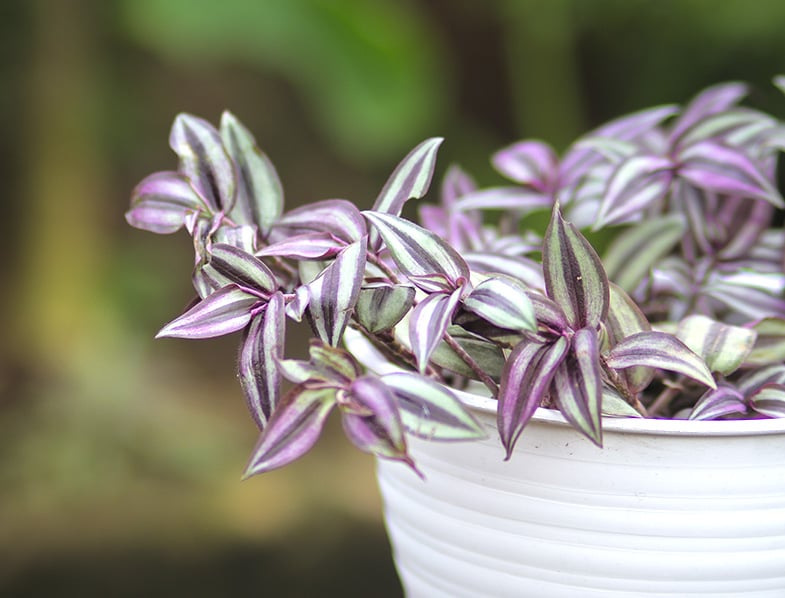
Tradescantia Fluminensis
This wandering Jew species features white flowers, and it’s a trendy indoor plant around the world. The species originates from the southeastern region of Brazil. It’s an evergreen perennial plant that flowers all-year-round and lasts for many years if the owner takes care of it correctly.
The oval-shaped foliage of the Fluminensis is green in color and has a glossy look. The leaves attach to fleshy stems, and the stem nodes quickly put roots down into the soil, allowing for the rapid spread and growth of the plant in ideal growing conditions.
When the plant flowers , it produces a set of flowers with three white petals. The flowers don’t bear any seeds, and they might also emerge in clusters. There are various sub-species of this plant as well, and some types, such as variegate, feature different leaf colors, such as yellow or cream streaks in the leaves.
The plant does best in USDA zones 9 to 12, as it loves the additional humidity in these regions as well. The wandering Jew doesn’t do well in colder climates, so stick to planting in the southern states.
The wandering Jew also prefers full sunlight during the day, and you’ll need to feed it a reasonable amount of water throughout the week. The plant doesn’t enjoy being dry for long periods.
Tradescantia Pallida
This variety originates in Mexico, and it’s the most attractive of the three Tradescantia genus. This wandering Jew produces long, pointy leaves that can reach lengths of 7-inches. The leaf will eventually turn a purple color, but the tips might remain red or green during the color transition.
There are visible segmentations on the stem of this wandering Jew, and it’s for this reason that many countries classify this plant as invasive.
The segments break easily, but they root readily, evolving into two plants with little care. Fortunately, for fans of the plant, it also makes it easy to grow the plants for cuttings as well.
Tradescantia pallida don’t like the cold, and it will die back in colder environments in the Northern states, especially if it grows outside. This wandering Jew produces small flowers that bloom in colors of pink, lavender, and white. The flowers feature three petals, and while they aren’t show-stopping, then do add a beautiful aesthetic to the plant.

- shipped in inproved box to save the plant

Last update on 2024-02-01 / Affiliate links / Images from Amazon Product Advertising API
Natural Air Cleaners
One of the reasons why the wandering Jew is such a popular house plant is its natural air-cleaning properties. The wandering Jew is an excellent “air scrubber,” and it removes bacteria and VOCs from the air inside your home, exchanging it for fresh air that enhances your home.
Some research also shows that the wandering Jew can assist in soil remediation, as well. The plant can remove heavy metals from the soil, helping restore the root health of other plants in the same flowerbed or pot.
Caring for Your Wandering Jew Plant
All varieties of the wandering Jew are easy to care for, provided that you grow them in the right climate and conditions. As long as the plant receives regular watering and pruning, it will thrive, and you’ll also manage to control the growth as well.
If you plant in a sunny spot in your home, then you can expect your tradescantia to last for many seasons. It’s also important to note that the plant might not flower it in its first season. However, by the third year, you should see plenty of flowers that emerge in the summer months.

As mentioned, the wandering Jew prefers sunny planting locations. The plant prefers later afternoon sun to morning sun, but it does well in any sunny area around the home. The more light you give the plant, the more flowers it produces in the flowering season.
If your wandering Jew does not get sufficient sunlight, you’ll notice that the color of the leaves starts to fade. Move the plant to a sunny spot, and it should recover in less than a week.
The wandering Jew enjoys a balanced moisture level in its soil . Don’t let the earth get too dry, as it might cause burning in the tips of the leaves. Likewise, the wandering Jew does not enjoy excessively wet soil either. The plant is susceptible to forming root rot if you “keep its feet wet.”
To check if it’s time to water your wandering Jew, push your finger about 1-inch into the soil. If it feels dry, then give your plant some water.
You must ensure you use a rich, loamy soil that drains well when planting your wandering Jew. When planting in a pot, make sure you add a layer of gravel at the bottom of the pot to enhance drainage. Add perlite to the soil to assist with drainage as well.
You can get away with using a standard potting mix when planting indoors , and other soil enhancements we recommend you add are the following.
- Coarse sand and perlite for drainage
- Humus or peat
- A light dusting of lime
- A few handfuls of rich organic compost
You want the soil to retain water but still allow optimal drainage.
During the growing season, fertilize your wandering Jew plant using a liquid-based fertilizer product. Make sure that you dilute the fertilizer to 50-percent strength.
Strong concentrations can result in burning in the tips of the leaves of the plant. You can also add a granular slow-release fertilizer to the soil once a year at the start of spring.
The wandering Jew grows quickly, and it might take over its pot in one or two seasons, depending on the size of the container. Therefore, you’ll need to pull up the plant and divide it from year-to-year, depending on its growth rate.
If you choose to re-pot your plant, make sure you use a pot that’s at least 50-percent larger than the old one. Line the pot with potting soil and a few handfuls of rich organic compost. Dig around the edges of the existing container to loosen the root ball. After loosening, pull the base of the plant to release it from the pot.
Move the plant to its new pot, and then fill with potting mix to cover the roots — Pat down the soil, and then water lightly.
Wandering Jew plants require regular pruning . The plant grows quickly, and if you don’t prune, then it can overtake the pot fast. Pruning also helps the stem, from getting “leggy,” meaning that the plant starts to look bare at the base. Pruning keeps the plant healthy and growing at an optimal rate.
All; you need to do is prune back any stems and pinch the stem tips. The wandering Jew will then send out two new shoots from the pinched top, helping your plant spread out into a bush-like appearance.
Propagation
The wandering Jew is easy to propagate . This plant grows quickly in a variety of conditions, which is one of the reasons why most countries list it as invasive. You can propagate your cuttings after your pruning session, without much effort.
Remove all of the leaves but the top set after pruning the stem. Place the cutting in another smaller pot with moist potting soil . Leave the container in the sun, and you should find that the cutting roots in a month.
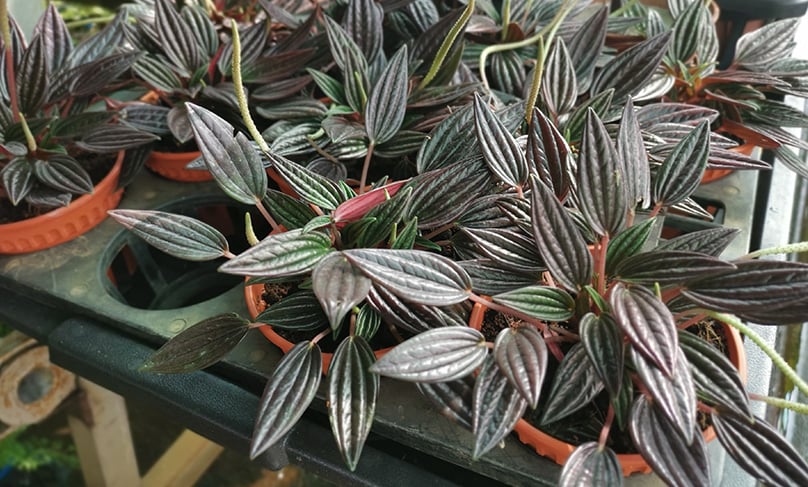
Being an indoor plant , the wandering Jew does not get much attention from pests. However, spider mites can be a problem for your plant if you don’t take care of it and watch for the presence of pests.
Spider mites are tiny spider-like bugs that form a web around the inside of the leaves of the plant. If left unmanaged and untreated, they might start to cause yellow spots in the foliage. The wandering Jew might also fail to flower in the summer months as well.
Over-watering your wandering Jew plant can result in the onset of diseases like root rot. Ensure that you have a well-draining soil mix before planting your wandering Jew. Provided that you do everything you can to ensure your soil drains well, you should never have a problem with root rot in your wandering Jew plant.
Wandering Jew Plants FAQS
What is the best way to grow a wandering jew plant.
The best way to grow a Wandering Jew plant involves placing it in a location that gets plenty of sunlight, preferably late afternoon sun. You should use well-draining, loamy soil to plant it, and ensure a balanced moisture level by watering it regularly but not excessively. The plant also appreciates humidity and occasional fertilizing with a liquid-based fertilizer diluted to 50% strength during the growing season. Pruning should be done regularly to manage its growth.
Is Wandering Jew easy to grow?
A: Yes, Wandering Jew plants are generally easy to grow. They adapt well to various conditions and are fast-growing. They can be propagated easily from cuttings and require minimal maintenance beyond regular watering, pruning, and an occasional application of fertilizer. However, they do not tolerate cold climates very well.
Does wandering Jew like full sun or shade?
Wandering Jew plants prefer locations with full sunlight. They can tolerate some shade but too much shade can cause the color of the leaves to fade. More sunlight exposure generally leads to more flowers during the flowering season.
How often do you water Wandering Jew?
Wandering Jew plants should be watered regularly to maintain a balanced moisture level in the soil. However, the soil should not be allowed to become too dry or too wet. Overwatering can lead to root rot. A good way to check if it’s time to water is to push your finger about 1-inch into the soil. If it feels dry, it’s time to water the plant.
Is Tradescantia Zebrina easy to grow?
Yes, Tradescantia Zebrina, a variety of Wandering Jew, is easy to grow. It requires similar care to other Wandering Jew varieties and is known for its adaptability and quick growth.
Does Tradescantia Zebrina need full sun?
Tradescantia Zebrina does best in a location with full sunlight. While it can tolerate some shade, insufficient sunlight can cause the leaves to lose their vibrant color. Like other Wandering Jew plants, the more light it gets, the more flowers it produces during its flowering season.

Hollie is a life-long gardener, having started helping her Dad work on their yard when she was just 5. Since then she has gone on to develop a passion for growing vegetables & fruit in her garden. She has an affinity with nature and loves to share her knowledge gained over a lifetime with readers online. Hollie has written for a number of publications and is now the resident garden blogger here at GardenBeast. Contact her at [email protected] or follow on twitter https://twitter.com/greenholliec
Pampas Grass Guide: How to Plant & Care for “Cortaderia Selloana”
Rhaphidophora tetrasperma guide: how to grow & care for “mini monstera”, corn plant guide: how to grow & care for “dracaena fragrans”.
under the photo “easy to propagate”, that is not a wandering jew-its a peperomia “rosso!”
My wandering jew plants leafs are getting dried. Why is that?
It’s not getting enough humidity
Could you elaborate on “rich organic compost”? What should it be made of, exactly? Can I use compost accelerator in the soil mix?
Worm castings are great, or worm tea, egg shell tea is another.
What month does the jew break ground to start growing?
All depends on your specific areas weather pattern and seasons.
Do NOT BUY ANY OF THIS SPECIES if you have a dog because dogs are very allergic to these plants & come out in bad rashes if they wander through them!
Leave A Reply Cancel Reply
Save my name, email, and website in this browser for the next time I comment.
Type above and press Enter to search. Press Esc to cancel.
- Growing Houseplants
- Indoor Garden Ideas
- Cactus & Succulents
- Houseplants Care
- Flowers & Blooms
- Gardening Guide
- Plant Care and Tips
- Beans/Fruit Vegetables
- Companion Planting
- Culinary Herbs
- Flowering Herbs
- Garden Design
- Gardening Ideas
- Growing food
- Growing Trees and Shrubs
- Leafy Vegetables
- Medicinal Herbs
- Patio Gardening
- Root Vegetables
- Shade Plants
- Temperate Fruits
- Tropical Fruits
- Balcony Gardening
- Container Fruits
- Container Gardening Ideas
- Container Herbs
- Container Vegetables
- Rooftop/Terrace Gardening
- Urban Gardening
- Vertical Gardening
- More Than Gardening
- Best and Top of Gardening

- Container Gardening
- Indoor Gardening
8 Types of Wandering Jew Plants+Care Tips

2-Minute Read
When it comes to versatility, there’s none like the adaptable wandering jews check all different types of wandering jew plants in this detailed article.
Wandering Jew Plant comprises various species in the Tradescantia genus. As the plant is adaptable to both indoor and outdoor conditions, it doesn’t matter if you are planning to have it as ground cover, in hanging baskets, or in containers; it’ll do equally well! Also, d o you know you can grow wandering jew in the complete shade, as well as in full sunlight? In full sun, it looks more colorful. Whereas, shade gives its leaves a greenish hue. Here are the Types of Wandering Jew Plants you should consider growing!
Have a look at the plants you can start with just one cutting and a glass of water here
1. tradescantia fluminensis.

It’s a popular indoor houseplant, which is also used as ground cover. Its white flowers are triangular and formed by three petals and look glorious attached to fleshy stems with oval-shaped leaves that are glossy and deep green.
Check out our article on colorful houseplants here !
2. tradescantia zebrina.
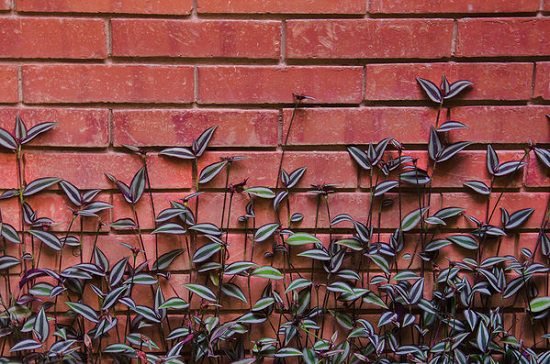
The variegated leaves resemble the stripes of the zebra, hence the name! The purplish-green foliage has a silver outer edge and white stripes running down lengthwise. It grows low to a height of 6-12 inches, and that’s why it can be grown as ground cover. It is one of the best types of wandering jew plants on the list.
3. Tradescantia pallida

It also goes by the name “Purple Heart” and is native to Mexico. Deep purple foliage, adorned with light purplish-pink flowers, looks marvelous and is the reason that it’s one of the most popular types of wandering jew plants! Apart from growing it as a striking ground cover, you can also have it in hanging baskets.
To know about more purple houseplants, click here !
4. tradescantia blossfeldiana.

Commonly known as the ‘Inch plant,’ it’s also referred to as Tradescantia cerinthoidebs . The thick green leaves have a fuzzy texture and a purple hue on the underside. You can easily propagate it from the cuttings, both in soil and water, once it gets growing. It bears delightful clusters of blue, purple, white, or rose pink flowers, making it one of the best types of wandering jew plants on the list.
5. Tradescantia Sillamontana

If precise geometric patterns are your thing, then you’ll love it because of its foliage. Growing from a thick succulent stem, the leaves are around two inches long and covered entirely in white hair. Magneta flower protrudes from the terminal end of the stem in summers.
6. Tradescantia spathacea
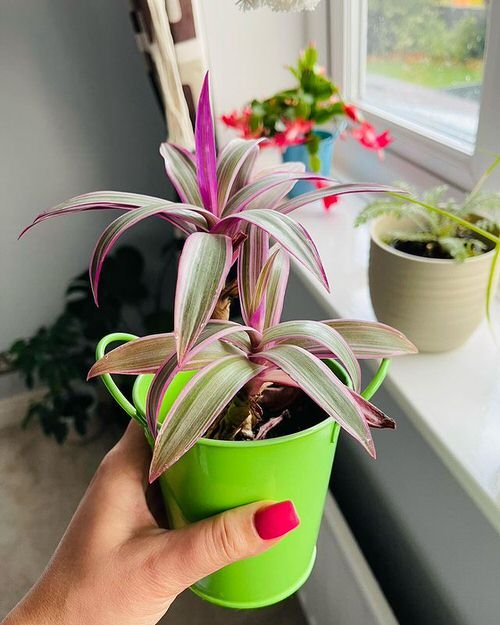
Known as Moses-in-a-basket, Oyster plant, or Boat lily, it is a sub-succulent herb from southern Mexico, Guatemala, and Belize. It grows in 6-12 inches long rosette and sword-like, narrow, and spiral-shaped dark green leaves, with purple bottom sides. The white flowers are enclosed with boat-like purple bracts, hence the name.
7. Tradescantia virginiana

Commonly known as the spider lily, it is a herbaceous perennial from the Commelinaceae family. The plant produces violet-purple to blue, three-petaled flowers, with yellow stamens and dark green arching leaves. You can grow this one of the most popular types of wandering jew plants under full to partial shade.
8. Tradescantia longipes
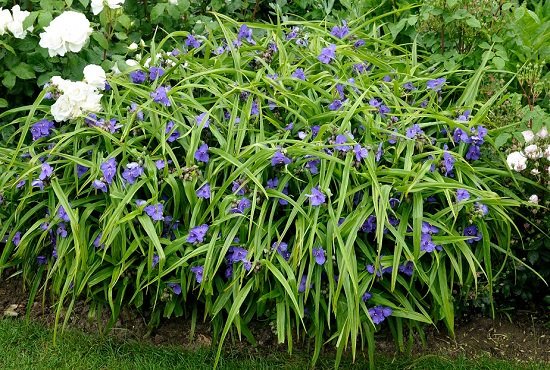
Adorn your garden by growing beautiful, purple-blue flowers of tradescantia longipes or spiderwort. It is native to Southern Missouri and northern Arkansas from the family Commelinaceae. Grow these three-petaled flowers for rock or naturalize gardens, in partial shade, by using well-drained, moist, acidic soil, making it one of the most popular types of wandering jew plants on the list!
Check out our article on indoor rock garden ideas here !
Wandering jew plant care tips.
- Grow a wandering jew plant in bright, indirect light or expose it to full sun, which it won’t mind either. Just keep in mind that low light can fade the markings on leaves.
- Water the plant directly around the roots, avoiding the crown, as it can result in rot.
- The plant prefers slightly moist soil, so maintain the right watering schedule.
- Use an all-purpose, water-soluble fertilizer, once a month, during the growing period.
Recent Posts
29 best pink fruits for garden and pots, 17 trees that look like a fern, 19 orchid arrangement ideas, 20 best plants for hanging from the ceiling, 9 succulents that make you lucky | good luck succulents, 5-6 foot evergreen shrubs for privacy, 7 diy memorial garden ideas, 24 iris arrangement ideas, join our 3 million followers:, related articles, 24 trendy snake plant arrangements for 2024, why everyone should have a spider plant at home: 8 reasons, how to grow cilantro indoors easily, how to make ponytail palm grow taller and large: 6 tricks, 8 different ways to grow houseplants without soil, how to propagate an elephant ear plant: 4 best ways.
dO YOU NEED TO BRING A POTTED PLANT INDOORS DURING THE WINTER MONTHS?
Depends on the plant and where you live. Do research on the specific plant.
Sooooo number 4…. Is not a blossefeldiana. It’s a flumensis. …. You posted a tri-color-mundula variegata……. Not a nanouk. A nanouk is a blossefeldiana centerthoides
LEAVE A REPLY Cancel reply
Save my name, email, and website in this browser for the next time I comment.

Get the Best of BalconyGardenWeb Directly in your inbox.
POPULAR CATEGORY
- Best and Top of Gardening 1580
- Flowers & Blooms 629
- Growing Houseplants 599
- Gardening Guide 413
- Gardening Ideas 381
© 2023 Balcony Garden Web | All rights reserved
- Privacy Policy
- Terms of Service
- Feedback Page

Wandering Jew Plant (Tradescantia zebrina): Types, How to Grow and Care
Sharing is caring!
Plants with trailing and creeping habits are some of the best plants to keep. They are fast-growing and make thick carpet of groundcovers for gardens in no time and they also create striking hanging indoor plants.
Among the all-time best trailers to grow is the wandering jew. Easy to maintain and drapes beautifully, this colored plant will make any space more inviting and interesting.
Medicinal Properties
Propagation and maintenance, what is a wandering jew plant.
Tradescantia is one of the 37 genera under the plant family Commelinaceae (1). Some of its 75 species are commonly called ‘wandering jew’ (also known as inch plant), a name they adapted due to their long lifespan like the Jewish character from a Christian folklore.
Another name for this group of herbaceous perennial plants is ‘spiderwort’ after the spiderweb-like sap they produce when the stem breaks. They are native to Canada, Mexico, and Argentina and have been naturalized in other parts of the world (2).
The most common tradescantia grown ornamentally is the T. zebrina also previously called Zebrina pendula . It has long fleshy stems where the wandering jew plant leaves and roots appear. The lance-like leaves are a mixture of green and purple with silver stripes on the upper side and deep purple under (3). The plant grows close to the ground and can only reach 20 to 30 cm high.
Does Tradescantia Zebrina Flower?
The wandering jew is considered an ornamental plant primarily because of its showy colorful foliage but the plant does produce pink flowers.
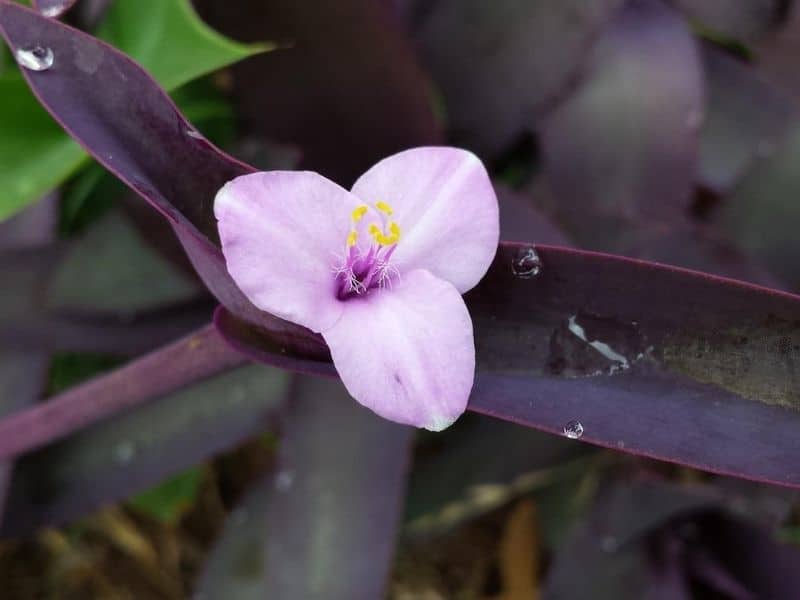
Small three-petaled pinkish purple flowers appear sporadically throughout the year (4). The resulting fruit is a capsule containing tiny brown seeds.
Is it Toxic to Pets?
Spiderworts are normally harmless plants but they contain toxic properties that may cause mild gastric problems and dermatitis to pets. Although they don’t lead to anything serious, it will be safe to keep the plants out of reach of pets and to keep the hands protected when dealing with the sap of the plant.
Because of the plant’s hardiness and adaptability to different environments, the wandering jew establishes well, in fact so well that it can be considered an invasive species. In countries like Australia, the plant has the capacity to invade natural vegetation. Although growing them is not prohibited, everyone is obliged to keep the plant’s growth under control (5).
Studies showed that Tradescantia has significant effects as an anticancer, antioxidant, and antibacterial medicinal plant. In traditional Chinese medicine, the wandering jew plant is highly valued as treatment for kidney failure.
The extract from the whole plant is cooked with dates, ginger, and water and consumed by patients. The plant is also known to treat high blood pressure, cough, urinary tract infection and tuberculosis (1).
How to Grow and Care for a Tradescantia
Here’s how to care for a wandering jew plant, one of the easy house plants to own.
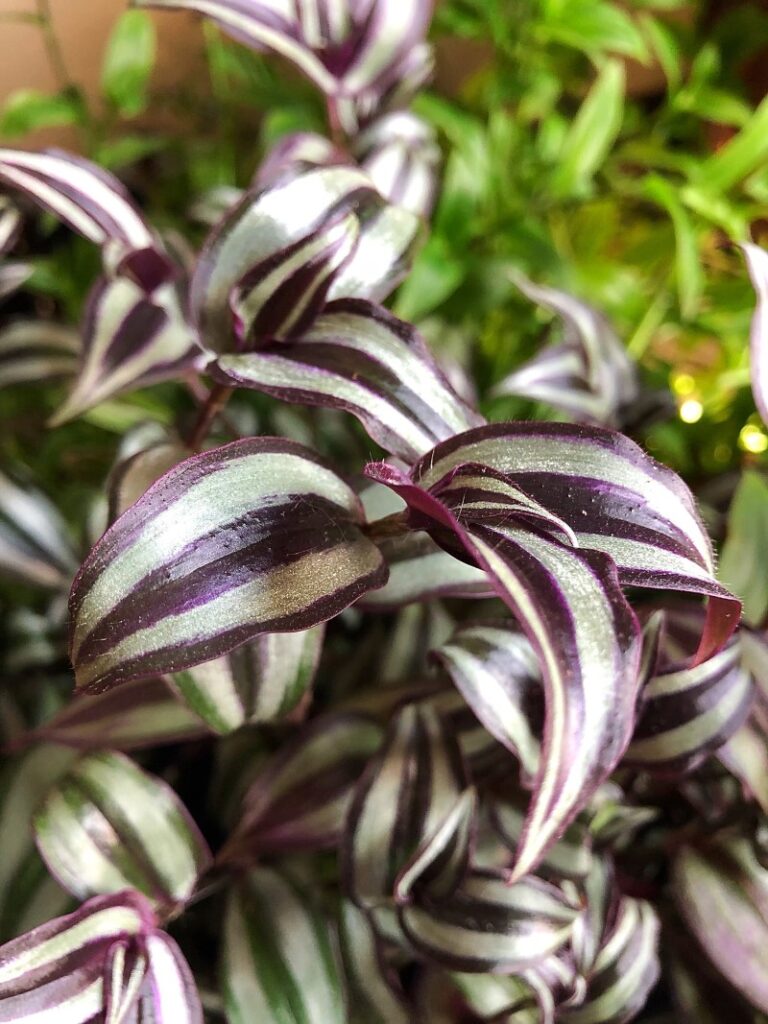
Light and Water
In the wild, the wandering jew plant thrives without assistance but under the right conditions. It likes filtered sun so indoor fluorescent light is enough. Placing them by the window and turning the plant every two weeks will keep the leaves colorful and the growth even on all sides (3).
The plant spreads easily in damp areas that’s why it naturally grows along riverbanks and roadsides. When potted, the soil should be kept moist but well-drained. Saturated soil often causes root rot.
Fertilize your Tradescantia plant once a month during the growing season (spring and summer) with a balanced, water-soluble fertilizer diluted to half strength. Avoid fertilizing in fall and winter when the plant is dormant. Over-fertilizing can lead to fertilizer burn and damage the plant, so follow the instructions on the fertilizer package carefully.
Temperature and Humidity
Spiderworts like it warm but there should be enough air circulation or else the leaves will sag. During the heat of the summer, taking the plant outside under shade will provide the necessary cool to the plant.
Mist the hanging plant early in the morning and late in the afternoon. If the plant is on a table, place a glass of water beneath the leaves or put the pot on a wet pebble tray. This will humidify the immediate vicinity of the plant aiding in its photosynthesis and transpiration processes.
Pests and Diseases
The most common living enemies of the wandering jew are aphids, mealybugs, scale, white flies, and spider mites. Manual removal at the onset of infestation is effective but they should be closely monitored as serious attack may lead to the plant’s death. If left unnoticed and the infestation has become severe, get rid of the plant by burning to avoid contamination.
Since the creeping inch plant is mainly soft almost like a succulent, soggy soil and too wet conditions lead to root and stem rot (4). As long as the plant is receiving just enough moisture, this disease will be avoided.
Propagating wandering jew plants is very easy. They can grow from seeds but will take years to establish so the more convenient stem cutting is best. The trailing or creeping stems form nodules where the roots will eventually grow as it comes in contact with the potting soil (2). When the hanging plant has longer trails than intended, it can be trimmed and the resulting stem cuttings can be rooted to form new plants.
There will be times that the potted wandering jew will become leggy, especially if it’s been receiving more shade. To promote a bushier growth pinch back by literally pinching the tip of the plant where the new growth occurs (4). This practice allows the formation of lateral stems.
In two or three years, these hardy plants may become pot bound, with the roots taking up most of the space in the pot. Repot in a larger container with a good mixture of soil, coarse sand, and compost to replenish the nutrients and provide room for the roots to breathe. Additionally, fertilize once every two months by foliar application just to improve plant vigor.
Common Varieties of Wandering Jew
The oldest and most common indoor wandering jew, this species has leaves alternating, often overlapping when young, purple leaves with silvery green thick stripes and solid purple underside. The stem is also a mixture of purple and green.
T. blossfeldiana
The leaves of this species are quite thicker, glossy, and covered in miniscule hairs called trichomes. The three-petalled flower is an ombre of white and pinkish purple with yellow anthers.
T. fluminensis ‘Tricolor’
This attractive variety showcases leaves with white, lilac, and green variegation. It appears smaller than the common wandering jew but bushier in form.
T. sillamontana
This whimsical species looks frosted with its silvery trichomes covering the entire plant. The green leaves are still alternately arranged but more compact which make a potted plant look more bushy than trailing. The light color of the leaves provide a complementing backdrop to the bright purple flowers.
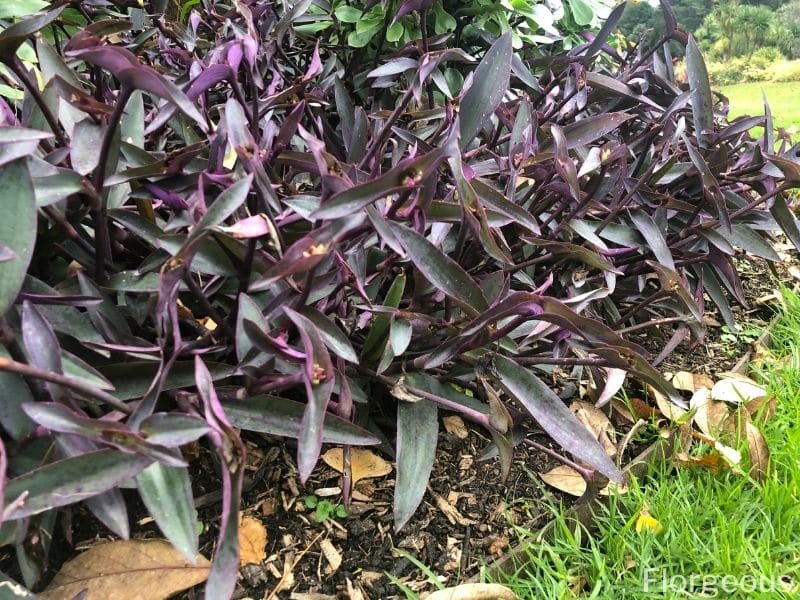
The leaves and stems of this species are in striking deep purple color hence the common name ‘ purple heart ’. Under shaded, they turn a hint of dull green. The leaves are also longer and have wider space in between.
Does Wandering Jew plant need full sun?
Wandering Jew plants (Tradescantia zebrina) prefer bright indirect light but can tolerate some direct sun, especially in the morning or late afternoon. However, prolonged exposure to intense sunlight may cause their dark green leaves to scorch.
How do you care for a wandering Jew plant indoors?
To care for a Wandering Jew plant indoors, place it in a location with bright, indirect sunlight, such as near a window. Water it when the top inch of soil feels dry, typically every 1-2 weeks, and provide well-draining soil. Additionally, mist the plant occasionally to increase humidity and remove dust from the leaves.
How do I make my Wandering Jew fuller?
To make your Wandering Jew plant fuller, prune it regularly to encourage branching and bushier growth. Pinch off the tips of the stems or trim back leggy growth to promote new growth and create a more compact appearance. You can also propagate wandering jew cuttings to create new plants and fill out the pot.
How long do Wandering Jew plants live?
Wandering Jew plants are generally long-lived when provided with proper care. With the right growing conditions indoors, they can thrive for several years, often becoming fuller and more lush over time with regular pruning and maintenance.
Reference List
(1) Dash, G., et. al. Tradescantia zebrina: A Promising Medicinal Plant. 2017. IAJPS, 4 (10). P. 3498-3502 .
(2) Arakelyan, H. Tradescantia zebrina- Mother Nature Healing. 2019. Researchgate.
(3) Vermeulen, N. Encyclopedia of House Plants. Taylor and Francis. 1999. P. 320.
(4) North Carolina State Extension. Tradescantia zebrina. NC State University. 2018. https://plants.ces.ncsu.edu/plants/tradescantia-zebrina/ . Accessed on 12 August 2020.
(5) The State of Queensland. IPA-Zebrina. Department of Agriculture and Fisheries. 2020. https://www.daf.qld.gov.au/__data/assets/pdf_file/0020/51284/IPA-Zebrina-PP102.pdf . Accesed on 12 August 2020.
Photo by Wirestock/depositphotos
Have you seen these?
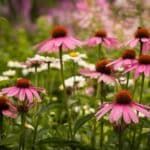
5 Best Coneflower Companion Plants and The Worst to Avoid
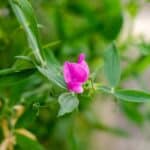
Enhance Blooms & Soil Health: Top 12 Companions for Sweet Peas
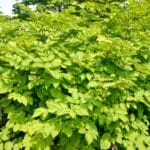
6 Best Aralia Sun King Companion Plants and Landscaping Ideas
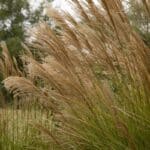
Growing and Caring for Maiden Grass (Miscanthus sinensis)

How to Grow and Care for Fountain Grass (Pennisetum)
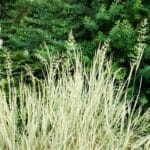
Growing and Caring for Blue Oat Grass (Helictotrichon sempervirens)
About the author.
Grow. Play. Every Day!

- House & Home
- Houseplants
Wandering Jew Care: How to Grow a Long and Luscious Inch Plant (Tradescantia Zebrina)
Tradescantia zebrina (commonly known as wandering Jew, spiderwort, or inch plant) is popular for a reason: This beginner-friendly houseplant is low-maintenance and grows quickly. It’s also super easy to propagate more plants so you can fill your home with more of the colorful striped foliage the species is known for.
Written by Linda Ly

When it comes to vigorous, colorful, and easy-to-grow hanging houseplants, there aren’t many that can compare to Tradescantia zebrina (known more commonly as wandering Jew—and I’ll touch on the history of that name below). Whether you’re a houseplant beginner or a veteran, most indoor gardeners have owned one of these potted plants at some point.
Keep reading for everything you need to know about Tradescantia zebrina and growing this stunning houseplant in your own home.
Disclosure: If you shop from my article or make a purchase through one of my links, I may receive commissions on some of the products I recommend.

About inch plants
Natural habitat.
Tradescantia zebrina is a native of Central and South America, from Mexico down to Colombia, as well as the Caribbean. Here, it forms part of the undergrowth in lightly forested and often very moist areas. It can form very dense, wide mats thanks to its creeping growth pattern and ability to throw roots extremely quickly.
Unfortunately, its vigorous growth has also made Tradescantia zebrina an invasive plant in some regions. This includes Hawaii, Brazil, and Australia, where the species easily takes hold in moist, forested areas.
As a 2019 study carried out in the Brazilian Atlantic Rainforest notes, this is problematic due to the species choking out native plants.
Some of the above was caused by careless gardeners allowing bits of the plant to get into the wild, where they quickly root. If you’d like to grow spiderworts like this one in your garden, please make sure to dispose properly of any trimmings left after pruning!
This also applies to zebrina’s popular cousins, like Tradescantia fluminensis, T. pallida, and T. spathacea.
Description
It’s not difficult to see why Tradescantia zebrina gained popularity as a houseplant. Wandering spiderwort plants (not to be confused with spider plants , another beginner-friendly species) are low-maintenance and grow just about anywhere—they even just grow in water !
Easy care and quick growth aside, spiderworts are also just good-looking plants. The pointed, oval leaves on thin, fleshy stems overlap slightly and are characterized by their zebra pattern in purple and silvery green. The leaf undersides are deep purple in color and the tiny, three-petaled flowers are bright pink.
Although this species is naturally a creeping plant, it’s often grown indoors in hanging planters. As long as the plant is provided with enough light, the foliage will be very dense and brightly colored, forming a spectacular waterfall that can reach more than 3 feet in length.
What’s in a name? In the case of common houseplants, sometimes a lot.
Tradescantia zebrina is a classic houseplant (I found mention of it in a 1964 German book about houseplants, but it’s probably been around longer than that!) and among most English speakers, it has long been known as wandering Jew. This is probably a reference to the “wandering” nature of the plant, as it does have a creeping growth pattern.
The legend of the wandering Jew is hundreds of years old and is now commonly considered to be rooted in antisemitism. It describes a Jewish man cursed to walk the planet until the Second Coming because he taunted Jesus on his way to the cross.
Because of this, the plant name has partly fallen out of fashion and has been the source of much debate in the plant world over the past few years.
Some plant enthusiasts have embraced the alternative “wandering dude,” which I personally think is a great option.
“Inch plant” (houseplant enthusiasts don’t agree on whether this refers to the fact that it can grow an inch a day, or that you only need an inch of stem to propagate it), “spiderwort,” or “wandering spiderwort” are also popular alternatives, though these are common names for other Tradescantia varieties, such as Tradescantia Nanouk.
The best way to avoid any confusion is to just stick to the scientific name.

Inch plant varieties
There are three subspecies of inch plant (wandering Jew): Tradescantia zebrina var. zebrina, var. flocculosa, and var. mollipila. Unsurprisingly, after it having been a popular houseplant for so many years, nurseries have also managed to create a whole bunch of cultivars through selective cultivation.
A few of the popular Tradescantia zebrina cultivars you may come across in your local plant store include, but are certainly not limited to:
- Tradescantia zebrina ‘Quadricolor’: Yep, as the name suggests, this one adds an extra color to the mix. The leaves are cream, pink-purple, light green, and dark green.
- Tradescantia zebrina ‘Burgundy’: Characterized by its very dark purple coloration.
- Tradescantia zebrina ‘Silver Plus’: Less purple, more shiny silver.
- Tradescantia zebrina ‘Red Gem’: Less silver, more intense (light) purple.
- Tradescantia zebrina ‘Purple Joy’: Less silver, more dark purple.
- Tradescantia zebrina ‘Tikal’: A rare, naturally occurring variety that collectors pay a pretty penny for.
Do keep in mind that most of these cultivars aren’t patented and the amount of mislabeling and variation within a cultivar are both huge. Just growing your wandering Jew in lower-light conditions can completely change the way it looks, so it’s not surprising that confusion sometimes reigns supreme.
Luckily, care is the same across all cultivars, so your best bet is to just enjoy your plant even if you’re not sure what Tradescantia variety you’re dealing with!
Where to buy wandering Jew plants:
- California Tropicals
- Daylily Nursery
- The Green Escape

Caring for an inch plant
Light and temperature.
It’s important to provide your Tradescantia zebrina with enough light. It’s tempting to use plants to brighten up dark, shaded spots in your home, but that just doesn’t work with this one: It loses its dense growth pattern and beautiful coloration in low light.
To prevent your wandering dude plant from growing sparse and green, place it near a window that gets bright indirect light. Some full sun isn’t a problem either, but do make sure you acclimate it gradually to a higher light location.
Temperature-wise, this species is a lot hardier than many of the tender tropicals we like to grow in our homes (like Anthurium andraeanum and Begonia maculata ).
Wandering dude plants can handle a very wide range of temps, making it perfect for those chillier windowsills that your other plants may not appreciate. Room temperature is ideal, but anything between 50°F to 85°F will keep them happy.
Water and humidity
Your Tradescantia zebrina will appreciate lightly moist soil. You can water a bit more during the summer months, when the plant is actively growing and needs a lot of moisture, and less during winter, when soil tends to take significantly longer to dry.
If you’re not sure whether it’s time to water your wandering Jew plant yet, you can always turn to the age-old trick of sticking a finger in the soil.
- If it still feels damp, wait a little longer, until the first inch or two has dried.
- If it feels bone dry, you’ve waited too long; you may also see limp leaves on your plant at this point. It’ll bounce back, but not always without lasting damage.
- If the soil feels wet, you watered too much and need to keep an eye out for root rot.
As for humidity, given its rather wet natural habitat, wandering Jew does appreciate higher air moisture levels. The great thing is, though, that it doesn’t demand it. As long as you keep its soil lightly moist and the air isn’t extremely dry, your plant should do well.
Soil and planting
Wandering Jew is not fussy about its potting mixture at all. I’ve grown it in pure houseplant potting soil with no additives. If you do want to take things to the next level, you can add some perlite and/or peat moss, although this is really not a must.
Most houseplant enthusiasts like to place their wandering Jew in a hanging planter so they can enjoy the look of the leaves cascading down. This is not a must, though. You can also emphasize the species’ creeping growth habit by filling up a large, shallow planter, growing it in a terrarium, or even keeping it in water on a semi-permanent basis.
Recommended products for wandering Jew plant care:
- FoxFarm Ocean Forest Potting Soil
- Espoma Organic Potting Mix
- Perfect Plants Organic Perlite
Fertilizing
Like most other houseplants, Tradescantia zebrina appreciates a bit of fertilizer during the growing season, which extends from spring to early fall. You can use a normal houseplant fertilizer according to the instructions on the bottle.
Don’t fertilize during the winter months unless your plant is growing well. It doesn’t need extra nutrients if it’s inactive.
Recommended fertilizers for wandering Jew plants:
- Houseplant Resource Center Liquid Fertilizer for Houseplants
- Instant Biologics Instant Plant Food (Fizzing Nutrient Tablets)
- Maxsea All-Purpose Seaweed Plant Food
Pruning
There’s a good chance you’ll have to prune your Tradescantia zebrina regularly, because as I mentioned, this is a very quick grower. It also roots very easily, so any trimmings can be replanted! I’ll describe how to do this in the section on propagation below.
Aside from stem trimming, you can remove any dead leaves, which are bound to pop up from time to time in very dense plants like this species.
Dividing or repotting
Inch plants don’t grow by producing plantlets at their base like many other houseplants (such as spider plants ) do. Instead, inch plants spread by rooting along the stems.
This means that division is not really the way to go; keeping these plants manageable is usually done through pruning. You can shape your plant by pinching off any long, leggy stems to create a fuller appearance and control its spread.
You’ll notice that Tradescantia really doesn’t mind being a bit cramped in its planter. Still, it’s a good idea to provide your plant with some fresh soil every year or two by repotting it.

Propagating an inch plant
If you’ve never propagated a houseplant before, this is truly one of the best species to start with. It’s known for rooting extremely quickly in both water and soil, meaning it’s easy to fill endless planters to keep or give away.
All you need to propagate your Tradescantia zebrina is a pair of clean scissors. Here’s how you do it:
- Snip the ends off existing branches. An inch or two with a few leaves works best.
- Remove the leaves at the bottom so part of the stem is exposed.
- Place the cutting in a glass of water to root or plant it directly in soil. You can put cuttings back in the mother plant’s pot to give her a fuller appearance on top.
- It can take a little longer during the winter months, but the first roots should appear within a week or so. You can give soil cuttings a slight tug to verify they’ve rooted.
- Once the first signs of new foliage appear, you’ll know your propagation attempt has been a success!
- If you propagated in water, you can leave the rooted cuttings in water almost indefinitely, although you can also pot them up in fresh soil.

Common questions about inch plant care
How do i make a wandering jew plant bushy.
By their very nature, wandering Jew plants are not bushy. Their creeping growth habit means they naturally grow leggy over time, especially in containers.
However, you can mimic a fuller appearance by strategically pinching off any long, spindly stems to shape the plant more. These stems can also be replanted near the mother plant.
As the baby plants grow, they’ll help fill in sparse areas and create the illusion of a bushy wandering Jew.
How long do wandering Jew plants live?
Wandering Jew plants have a limited lifespan of just a few years, and as a potted plant, you’ll notice your wandering Jew becoming very leggy after just two to three years.
Unlike other fast-growing plants that benefit from pruning, cutting back a wandering Jew doesn’t work well to renew its growth; it simply controls the spread.
The best way to keep your plant coming back year after year is to propagate new plants from stem cuttings, which—fortunately—is super easy with a high success rate.
Is wandering Jew perennial?
Wandering Jew (Tradescantia zebrina) is a trailing evergreen perennial in its native habitat (USDA hardiness zones 9 through 12). Where it’s not winter hardy, wandering Jew is grown year-round as a houseplant.
Are wandering Jew plants toxic to cats and dogs?
Wandering Jew is not considered outright toxic, but it can cause some skin irritation. If your pet gets into your plant, don’t worry too much, although it can be a good idea to have a look in its mouth to make sure there’s no excessive swelling. Be sure to offer water. To prevent skin rash, it can be a good idea to wear gloves if you need to handle your wandering Jew plant. This especially applies if you have sensitive skin.
https://www.cabi.org/isc/datasheet/110354
Racism in Taxonomy: What’s in a Name?
Chiba de Castro, W. A., Xavier, R. O., Garrido, F. H., Romero, J. H., Peres, C. K., & da Luz, R. C. (2019). Fraying around the edges: negative effects of the invasive Tradescantia zebrina Hort. ex Bosse (Commelinaceae) on tree regeneration in the Atlantic Forest under different competitive and environmental conditions. Journal of Plant Ecology, 12(4), 713-721.
Encke, F. (1964). Pflanzen fur Zimmer und Balkon; Auswahl, Pflege, Vermehrung.
I'm a plant lover, passionate road-tripper, and cookbook author whose expert advice and bestselling books have been featured in Time, Outside, HGTV, and Food & Wine. The National Parks Cookbook is my latest book. Garden Betty is where I write about modern homesteading, farm-to-table cooking, and outdoor adventuring—all that encompass a life well-lived outdoors. After all, the secret to a good life is... Read more »
We bought a full grown Bolivian Jewel mid summer last year. It was in a 14” raised pot and flowing 2 foot over the sides. It was beautiful next to our fountain outside. We live in Minnesota so we had to discard it in the late fall since we had no place to care for it in the house. Since we can’t find another like it we’d like to plant one from scratch but how. We still have the pot and riser but have no idea how to start from that. One plant, a few or just how many to make a bushy over grown plant so it looks like the one we purchased last year. Does this make sense or should we just forget it since it is already the middle of May. The greenhouse that we bought it from last summer doesn’t have any this year, just small ones in 4” pots. Thanks
If you can only grow it as an annual (and won’t be overwintering it indoors), you can plant a few smaller ones together to make them look fuller as they grow.
It seems counterproductive to talk about the problematic origin of the name wandering Jew, recommend multiple alternative names (including scientific), but then continue to call it wandering Jew in the rest of the article. If the name is anti-Semitic just set a good example and use a different name.

Leave a Reply Cancel reply
Your email address will not be published. All fields are required.
Save my name and email in this browser for the next time I comment.
This site uses Akismet to reduce spam. Learn how your comment data is processed .
Recommended Reads
- Garden of eatin’

The No-Dig Garden Method: Make Amazing Soil With Less Work

Solarizing Your Garden: How to Use the Sun to Control Weeds and Pests in the Soil

How to Plant a Three Sisters Garden: The Original Companion Plants

How Much to Plant for a Year’s Worth of Food

What You Should Know Before Buying Land (My Real-Life Tips)

Construction Loans: What I Wish I’d Known As a First-Time Borrower

Dark Room? 9 Actually Low-Light Plants That Don’t Need a Lot of Sun

Getting Rid of Fungus Gnats: 11 Remedies That Really Work

My Favorite Ruby Red Sauerkraut Recipe (and Why It’s So Good For You)

How to Make Nukadoko (Fermented Rice Bran Bed) for Pickling

Easy 4-Ingredient Colorful Homemade Pasta—No Pasta Maker Needed

The Best Homemade Limoncello
Sign up for my free weekly newsletter.
And get game-changing emails full of tips and resources that’ll level up your garden this year.
- About Linda Ly
- What’s In My Garden
- Lazy Gardening Academy
- Sponsorships
- Site Policies

Back to the top
Disclosure: Garden Betty independently selects products to feature on this site. I may receive a commission when you buy something through one of my links. As an Amazon Associate, I earn from qualifying purchases.
© 2024 Garden Betty. All Rights Reserved.

Home » House Plants » Wandering Jew
Tradescantia Nanouk Care: Growing The Nanouk Wandering Jew

Tradescantia Nanouk® (trad-es-KAN-tee-uh NAN-uhk) is also known as Fantasy Venice and Tradescantia albiflora ‘Nanouk’ (al-BIH-flor-uh).
This Nanouk Tradescantia plant is a new cultivar developed by cross-pollinating two selected seedlings of Tradescantia albiflora . It is a patented plant with the United States Patent number PP29711.

“Nanouk” has a few other common names, such as Nanouk tradescantia, Fantasy Venice, Wandering Jew, Spiderwort, and Tradescantia bubblegum.
This trendy plant was developed in the Netherlands in 2012 through a planned breeding program focused on creating a more compact type of Tradescantia with impressive flowers and highly dependable performance.
Although Tradescantia plants originated in Mexico, South America, and Central America, it can truly be said that this plant originated in Sappemeer, The Netherlands.
All Tradescantia plants are herbaceous perennials and are members of the plant family Commelinaceae (ko-mel-ih-NAY-see-eye).
“Summary of Invention” For Tradescantia Nanouk® as filed with the US Patent Office on March 28, 2017
The following traits have been repeatedly observed and are determined to be the unique characteristics of ‘Nanouk.’ These characteristics, in combination, distinguish ‘Nanouk’ as a new and distinct Tradescantia plant:
- Compact and upright to broadly spreading plant habit.
- Strong and healthy leaves.
- Light purple, green, and greyed green-colored leaves.
- Good interiorscape performance.
Plants of the new Tradescantia and the parent selections differ primarily in leaf color, as plants of the parent selections have white and green-colored leaves.
Plants of the new Tradescantia can be compared to plants of the Tradescantia spathacea ‘Tricolor,’ not patented. In side-by-side comparisons, plants of the new Tradescantia and ‘Tricolor’ differ primarily in leaf shape as plants of new Tradescantia have shorter and more rounded leaves than plants of ‘Tricolor.’
Plants of the new Tradescantia can also be compared to plants of the Tradescantia albiflora ‘Albovittata,’ not patented.
Nanouk Plant Quick Care Tips
- Botanical Name: Syngonium podophyllum
- Common Name(s): Nanouk Plant, Arrowhead Plant
- Synonyms: N/A
- Family & Origin: Araceae family, native to Mexico, tropical rainforests of Central and South America
- Growability: Easy to grow
- Grow Zone: USDA zones 10-12
- Size: Grows up to 2-3′ feet tall and wide
- Flowering: Rarely flowers indoors
- Light: Bright, indirect light
- Humidity: Prefers high humidity, mist regularly
- Temperature: Keep in temperatures between 55-75°F
- Soil: Well-draining soil
- Water: Water when the top inch of soil is dry, do not overwater
- Fertilizer: Fertilize once a month during growing season with a balanced fertilizer
- Pests & Diseases: Susceptible to spider mites, mealybugs, and scale insects. Can also be affected by root rot if overwatered.
- Propagation: Propagated through stem cuttings in water or soil
- Plant Uses: Great for adding greenery to indoor spaces, can also be used in terrariums or as a hanging plant.
In side-by-side comparisons, plants of the new Tradescantia and ‘Albovittata’ differ primarily in leaf color, as plants of ‘Albovittata’ have white and green-colored leaves. [ source ]
Grooming and Maintenance
Taking stem cuttings – propagating tradescantia, is nanouk considered invasive, tradescantia nanouk care, size and growth.
Nanouk Tradescantia has a very compact and upright growth habit and spreads freely. It is considered a fast grower. The plant typically reaches a height and width of just under three-and-a-half inches.
The plants’ stems are thick, and the leaves are smooth on the top and a bit furry on the underside. Green, pink, and white stripes on large, lush leaves with cute little white and yellow flowers that grow from pink buds.
The variegated leaves of Tradescantia Nanouk are impressively healthy, strong, and rather plump. Leaf coloration is quite lovely in shades of green, light purple, grayish green, pink, and cream.
Flowering and Fragrance
Flowers may be either pink or white and appear continuously throughout the plant’s growing season, which is spring through early autumn.
When kept indoors, Tradescantia Nanouk may also bloom through the winter months.
Nanouk Plant Care: Light & Temperature
Tradescantia albiflora ‘Nanouk’ does well in bright indirect sunlight or in full sun. Indirect bright light leads to greater flower production. Too little light will cause the foliage to fade.
Some direct sun is beneficial, but make sure not to overdo it since the leaves can get bleached or sunburned from too much direct sunlight.

If you want to increase the humidity, we suggest you mist it often, place it near a humidifier, or use a pebble tray.
The ideal daytime temperature for the Nanouk Tradescantia cultivar is between 55° and 75° degrees Fahrenheit. Outdoors, this Tradescantia is winter hardy in USDA hardiness zones 10 through 12.
Watering and Feeding
Overwatering is far more problematic than underwatering. Allow the soil to become almost dry, and then water thoroughly.
Generally speaking, Tradescantia Nanouk will do well with weekly watering. Never allow the plant to stand in water.
Tradescantia nanouk requires a moderate amount of water when planted in potting mix with good drainage. Allow the water to drain freely out a drainage hole, and then return the plant to its home!

As with most Tradescantia, this cultivar does not really need fertilizer. Over-feeding can lead to brown leaf tips.
If you do want to fertilize your plant, give it a half-strength solution of a good quality liquid houseplant fertilizer.
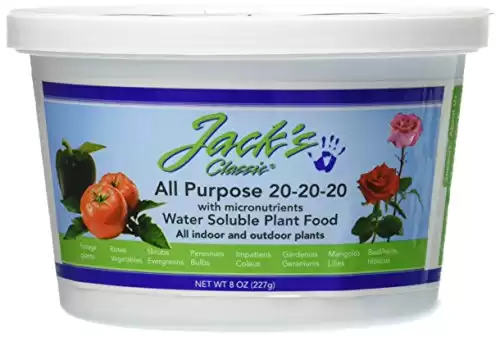
Alternately, give the plant a top dressing of vermicompost first thing in the spring.
Soil and Transplanting
Good drainage is a must. If your soil tends to be a bit heavy, add some perlite or coarse sand to lighten it up.
When potting your Tradescantia Nanouk, it’s important to use a standard well-draining houseplant soil mixed with coarse sand, orchid bark, or perlite.
Nanouk Tradescantia does well in any high-quality potting soil mix or container mix when kept as a potted plant.
You can improve the quality of the soil by adding organic matter such as compost, mulch, or peat moss.

Don’t worry if you have to do a bit of root ripping. Then plant each in separate small pots using well-draining soil.
You can also check if the roots are poking out of the bottom of the container. This is a sign that you should repot your plant.
Repotting is crucial for plant health because the old, oxygen-deprived, compacted soil is removed in this process.
When kept outdoors as a landscape plant, all of these caveats apply. Be sure that your soil is amended properly so that it supplies nourishment, holds the right amount of moisture, and allows excess moisture to drain away.
Even though Tradescantia Nanouk is bred to be compact, it still has some of its cousins’ sprawling and wandering habits. Keep the plant pinched back to encourage bushier growth.
Light pruning of dead and damaged foliage is recommended, and though fertilizing is not necessary, if you’d like to give your plants a boost, then it’s best to fertilize them in spring and summer.
Pinching new growth or cutting back your Tradescantia Nanouk will encourage it to grow fuller and bushier. The leaves will also be a bit smaller, with much more green and less variegation.
If your plant begins to sprawl and looks a little bit thin at the top, trim off leggy cuttings and poke them into the soil in the center of the pot. They will quickly take root and fill out your plant.
Tradescantia Nanouk Propagation
As with all Tradescantia, propagation is a breeze. Just trim off cuttings and start them in soil or in water.
Tradescantia Nanouk Pests or Diseases
Excessive watering is the main problem for all Tradescantia. Too much water can cause root rot and fungal infections. This may lead to trouble with fungus gnats.
Anytime your Tradescantia Nanouk plant seems to be less than healthy and happy, the first thing you should do is check to see if the soil is soggy. If it is, allow the plant to dry out completely before watering again.
Trim away any stems and/or leaves that seem to be damaged or rotten. You may also wish to take healthy cuttings at this time just in case root rot causes the demise of your main plant.
On the flip side, if you allow your Tradescantia Nanouk plant becomes too dry, you may experience trouble with spider mites.
These can be avoided by maintaining a correct watering schedule and by increasing humidity levels around your plants.
You can do this by misting and/or placing your plants on a pebble tray with a bit of water. Be sure the water doesn’t touch the bottom of the pot. It is intended to evaporate around the plants and increase humidity.
Spider mite infestation can be addressed by giving your plant a vigorous shower with fresh water.
Follow up by misting the plant with a 50-50 solution of water and isopropyl alcohol. You may need to repeat the misting several times to kill off all the spider mites and their eggs.
Is Nanouk Considered Toxic or Poisonous to People, Kids, and Pets?
The sap of all Tradescantia can be irritating to the skin and may cause gastric distress if ingested. Wear gloves when handling your plant and/or wash up immediately after you finish trimming.
Related: Have you ever wondered: Is Wandering Jew Poisonous?
Keep pets away from Tradescantia plants, as the sap can cause stomach upset if ingested and may cause dermatitis if it comes in contact with the animal’s skin.
Tradescantia of all sorts are considered invasive plants in the state of Florida. This type of plant naturalizes and spreads easily in any tropical environment.
Suggested Tradescantia Nanouk Uses
Tradescantia Nanouk can be used as a groundcover in tropical areas, but it was really developed to be kept as a houseplant.
It’s pretty colors and hardy leaves make it a good choice as a tabletop or desktop plant.
Another popular variation is the inch plant (T. cerinthoides), earning its name for its tendency to ‘‘inch along’’ as it grows along the ground or trails downward from a hanging planter.
It can do well in hanging baskets as it creates a fuller and more controlled appearance than other types of Tradescantia.
This pretty, colorful plant also does very well in mixed planters. The Tradescantia Nanouk plant is a perfect addition to any houseplant collection.
JOIN Our FREE Plant Care Newsletter
By entering your email address you agree to receive a daily email newsletter from Plant Care Today. We'll respect your privacy and unsubscribe at any time.

Tradescantia Nanouk Care #1 Best Tips in a Nutshell
By: Author Daniel
Posted on Last updated: January 24, 2022
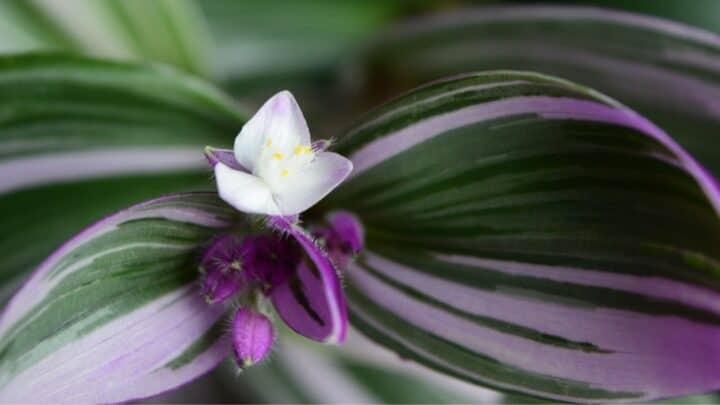
Sharing is caring!
- Facebook 32
Tradescantia Nanouk is not difficult to care for if you keep in mind its basic needs and some of its special quirks.
All Tradescantias are easy to grow, colorful, and very beautiful and are beloved as houseplants the world over.
But, Tradescantia Nanouk is special: pink, purple, green, and white stripes create a stunning pattern on its leaves, looking like each leaf has been brushed by a talented painter.
Tradescantia stems are thick and chunky, providing sturdy support to rounded, fuzzy thick leaves. Small, charming pink buds and white and yellow flowers show up in spring and summer.
T radescantia “Nanouk” branches grow upright. It takes a very long time and excellent growing conditions for this lovely plant to start trailing.
Tradescantia “Nanouk” has been created in 2012 by plant scientists in the Netherlands to be more hardy, vigorous, and beautiful. They certainly succeeded!
Table of Contents
Tradescantia Nanouk Care
Tradescantia Nanouk needs bright indirect light to keep the vivid colors of its leaves, well-draining soil using orchid bark, perlite, and some horticultural sand to avoid root rot, and watering from below so that the leaves do not rot. Water every 2-3 weeks. The temperature should be within 60-75°F (16-24°C). A humidity level of 40-60% is ideal. Fertilize monthly using a balanced fertilizer diluted to half-strength in spring and summer.
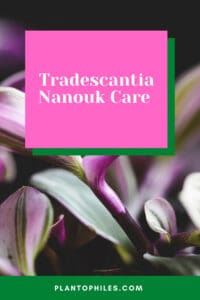
Tradescantia nanouk Care
Like other Tradescantias, Tradescantia “Nanouk” likes free-draining soil that never allows roots to be wet.
You can use any good-quality commercial soil mix for houseplants, but your plant would benefit from adding a bit of orchid bark, perlite, and some horticultural sand.

It is very important that the soil is light as dense soil can cause root rot. You can learn to make your own excellent potting mix .
Watering your Tradescantia Nanouk the right way is the biggest difference between having a happy, thriving plant and, well, a sad, yellowing one with rotting leaves.
Because of its dense growth and closely furled leaves, it is not a good idea to water your Nanouk from above. It is very likely that the water trapped in the leaves will cause the leaves to rot.
You can try to water it very carefully from above by pouring water into the soil, avoiding touching the leaves.
Also, you can water the plant by soaking the entire pot in tepid water for an hour or so and then letting the excess thoroughly drain from the hole in the pot on a drip tray.
Make sure that your Tradescantia “Nanouk” actually needs watering by touching the soil with your fingers.
If the first few centimeters (an inch or so) of soil are dry, give it a good soaking. Otherwise, wait for a few days.
During its active growing season in Spring and Summer, water your plant every two to three weeks.
You will see that it needs much less water in the fall and winter. Also, keep in mind that plants getting northern light need less watering.
Tradescantia “Nanouk” thrives in bright, indirect light, so if you can, place it near the north or east-facing window .
If your plant is facing north, it will get less light so it will need less water.
You will know that you are not giving your plant enough light if it starts looking leggy or its lovely colors start fading away and turning basic green.
Too much light will turn the leaf edges crispy. Just the right amount of light will make your Tradescantia start forming buds and blooming in the growing season.
Never place your Tradescantia in full sun.
Temperature
Tradescantia Nanou” grows best in temperatures between 60-75°F (16-24°C).
The night temperatures should not fall below 50°F (10°C).
Keep the temperature consistent and never place your plant near a heat source or draft.
Keep a humidity level of 40-60% for Tradescantia Nanouk.
A humid environment is ideal for making your Tradescantia “Nanouk” happy and thriving.
It is fairly easy to give it all humidity it needs. Many homes these days use humidifiers. If you do, your plant will thank you.
You can place your Tradescantia pot on a tray of pebbles filled with water.
You can also place your plant on the bathroom window, where it will not be sprayed by the shower but will enjoy the steam from your bath. As a bonus, your bathroom will look luxurious.

Tradescantia nanouk thrives in a humidity between 40-60%
Tradescantia Nanouk is a vigorous grower and in the growing season in spring and summer benefits from a monthly feeding using a balanced fertilizer diluted to half-strength.
If you prefer the organic route, make a compost tea by soaking your compost in a bucket of water for a few days.
Drain the resulting ‘tea” and dilute it in half. Use this organic fertilizer to feed your Tradescantia and any other house plant that needs feeding.
Stop feeding after the growing season ends.
If you completely neglect to feed your Tradescantia ‘Nanouk”, it will not be worse for it and you will probably not notice the difference.
Never fertilize your plant right after repotting.
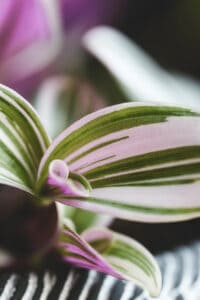
Feed Tradescantia nanouk monthly in spring and summer
Tradescantia “Nanouk” is a vigorous grower and it will probably fill the pot with roots in one growing season.
It means that you should re-pot it once a year or so. Plant it in a container one size larger than before.
In fall and winter, leave your plant alone to rest.
Because your plant is such a fast grower, you might need to re-pot it more often. Here are the signs that it is time for it:
- The roots are growing out of the drainage hole;
- You can see the roots circling the soil inside the pot.
Check your plant during the growing season by lifting it gently out of the pot. If it is easy to lift the whole root ball and the soil, it probably has more roots than soil. It means it is time for repotting, fresh soil, and a bigger pot.
Give your Tradescantia a good soaking after repotting.
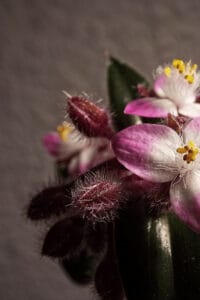
Tradescantia nanouk is a vigorous grower
You can prune your Tradescantia “Nanouk” at any time by pinching new growth or cutting back its branches. Regular pruning will make it grow denser and bushier.
Use sharp, sterilized garden cutters to pinch new growth or branches, or use your fingers.
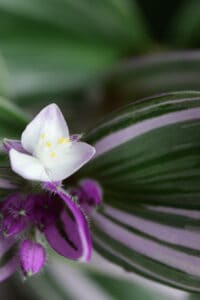
Tradescantia nanouk is easy to care for
Propagation
Propagate your Tradescantia ‘Nanouk” by planting the branch cuttings or pinched new growth.
You can place the cuttings back into the same pot, around the rim. It will make the plant look bushier and the cuttings will grow happily in the familiar environment.
You can also place cuttings in water until they grow roots.
Trim the first few pairs of leaves before placing the cuttings in a jar half-filled with water (use distilled water if your water is hard.) Make sure no leaves are in the water, just the stem.
Let the roots grow until they are an inch or so long before planting your cuttings in the soil. If you let your roots grow in water too long, they will become too soft and will get crushed by the soil
When propagating your cuttings in the water, you will be able to see when the new roots are ready to be planted.
You can also propagate your cuttings in the soil. Just stick each cutting in a small growth pot and water it well. You can expect the roots to grow in a few weeks.
Plant three or four newly rooted cutting in the same pot to make the new plant look bushier.
Nanouk stems are fairly thick so they might take longer to root. Just be patient.
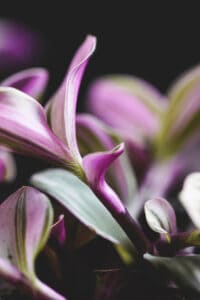
Tradescantia nanouk has beautiful green, white and pink foliage
If you provide your Tradescantia “Nanouk” with ideal conditions, it will reward you with charming little blooms.
The buds are purple-pink, opening into white or pink flowers, which may bloom throughout the growing season – from spring to the end of summer.
Some really healthy, strong plants will continue to bloom indoors throughout the year.
Tradescantia “Nanouk” grows vigorously, producing brightly colored leaves on thick branches.
Bright, indirect light allows this plant to produce more vivid patterns on the eaves and thicker, denser growth.
If the plant does not get enough light, it becomes leggy, resembling other trailing Tradescantias. Some growers prefer it, but they lose colored leaves as a price.
Tradescantia “Nanouk” will develop trailing branches in time, as the branches grow and the heavy leaves pull the branches down.
Common Problems with Tradescantia Nanouk
T radescantia s are in general resistant to pests and Nanouk has been developed to be even more resilient than its relatives. But, It is not completely immune, especially if the growing conditions are less than ideal.
If the growing environment is warm and dry, mealybugs can show up. You will know you have a mealybug infestation if you see sticky honeydew on the branches and leaves. This honeydew attracts insects and fungus. Clean the honeydew with a cotton ball soaked in alcohol or, for the organic solution, spray the plant with neem oil.
Spider mites
A dry environment is also conducive to s pider mites infestation, especially if the plant is weak and allowed to dry out. Spraying your plant with neem oil will get rid of spider mites. You can prevent your plant from being infected with mites by increasing the humidity and leaving more space between plants to allow air circulation.
Root and leaf rot
Overwatering, especially if the soil is too dense, will cause root rot.
Watering the Tradescantia “Nanouk” from above might cause a leaf rot if the water gets trapped in leaves.
Prevention is always better than having to deal with plant problems. Provide your Tradescantia with a warm, humid environment with bright, indirect light and it will live happily and trouble-free.
Tips for growing a healthy, vigorous Tradescantia “Nanouk”
- Keep your Tradescantia in bright, indirect light to encourage bright color of its leaves and compact growth;
- Soak your plant from below to avoid leaf rot. It is always better to give the plant one good soaking with the excess water draining thoroughly than frequent watering;
- Make sure the soil you use is free-draining and light;
- In the fall and winter, water your plant less and do not fertilize in at all;
- Keep the humidity levels between 40 to 60 percent.
Frequently Asked Questions about Tradescantia Nanouk Care
Why is my tradescantia nanouk losing its colors.
Your Tradescantia Nanouk is not getting enough light. Place it near the eastern or northern window, in bright indirect light, and the colors will improve.
The leaves of my Tradescantia Nanouk are turning yellow and dropping. What am I doing wrong?
You are watering your plant from above and some of the water is being trapped in the leaves, causing them to rot. Instead, soak the entire pot in tepid water once a month or so, when the top of the soil dries out. Let the excess water drain thoroughly through the drainage hole in the pot.
Is the Tradescantia Nanouk toxic?
Tradescantia Nanouk is toxic to pets and children. Make sure you place the pot out of their reach.
My Tradescantia Nanouk looks miserable and it might be dying, what can I do?
You might be able to save your plant by taking it out of the pot, washing away all the old soil, and cutting away all the rotting, damaged roots. Plant the Tradescantia in fresh, free-draining soil and put it on a window sill in a humid, bright light, such as a bathroom window sill. If you have enough healthy roots left, the plant has a chance of recovering. Prevent this from happening by using free-draining soil and water the plant only when the top inch of the soil is dry.
Why are the leaves of my Tradescantia Nanouk dry and crispy at the edge?
Your plant is getting too much light or is in direct sun. Move it to a spot with indirect light and provide enough humidity. You can place the pot on a tray filled with wet pebbles.
Can I place my Tradescantia Nanouk outside on the porch?
Tradescantia Nanouk is a very beautiful plant that will give you years of pleasure, colorful leaves, and even tiny white flowers if it is really happy.
It requires very little care, as long as you give it plenty of indirect light, humidity, and free-draining soil. Water only when it needs it, once a month or even less in the winter.
The more indirect light your Tradescantia has, the more stunning its colorful leaves will become. Make it into a spectacular décor for your bathroom by placing it at the bathroom window.
Its compact growth makes it even suitable for a dining table or a side table in the living room as long as there is enough light.
You can make wonderful gifts to your friends by propagating your plant’s new growth or branch cuttings. When you are trimming your plant, do not throw out the cuttings.
Plant them in water or soil until the roots grow and place four or five rooted cuttings in a nice pot for a wonderful gift.

Daniel has been a plant enthusiast for over 20 years. He owns hundreds of houseplants and prepares for the chili growing seasons yearly with great anticipation. His favorite plants are plant species in the Araceae family, such as Monstera, Philodendron, and Anthurium. He also loves gardening and is growing hot peppers, tomatoes, and many more vegetables.
Related Posts
Rubber plants share a long history due to their wonderful uses and benefits for the…
Botanically known as Kalanchoe gastonis-bonnieri, this plant is grown for its quirky foliage. Due to…
The Donkey's Tail, also called Burro's Tail or Sedum morganianum (botanical name), is a succulent…
(image credits, IG:oohyouplantsy) I have a hide-away in my home that I escape to for…
I love plants that offer an eye-catching burst of color. They sure put a smile…
Do you want a herb garden at home and are thinking of buying or planting…

How To Propagate Wandering Jew In 2 Easy Ways
Tradescantia zebrina or Wandering Jew is a plant loved for its striking looks and hardy nature. These plants can be grown both indoors and outdoors in America. They thrive in warm climates and are pretty easy to take care of. Read on for a complete guide on how to propagate Wandering Jew in soil and water.
- 1.1 Step 1: Take Cuttings
- 1.2 Step 2: Prepare the Pot
- 1.3 Step 3: Aftercare
- 2.1 Step 1: Get Cuttings
- 2.2 Step 2: Prepare the Water
- 2.3 Step 3: Aftercare
- 3 When to Propagate Wandering Jew
- 4.1 General Care
- 4.2 Potential Problems
- 5.1 Do you cut above or below the node?
- 5.2 Can you propagate a Wandering Jew from a leaf?
How to Propagate Wandering Jew in Soil
Propagating Wandering Jew plants in soil takes a little more effort than propagating them in water. Both methods have a high success rate, so you don’t need to worry about your efforts going to waste.
Step 1: Take Cuttings
Taking cuttings the right way is crucial for propagation . Use a sterilized sharp blade or pruning shears for clean cuts. If possible, cut at a 45-degree angle to help the cuttings take root faster.
You need to cut below a leaf node. These leaf nodes will sprout roots for the propagated plant. If there aren’t any leaf nodes, just make a cutting below the newest leaf. Your cuttings should be about 4 to 6 inches long.
Let the cuttings dry out so they can form calluses. This protects the cuttings from rotting once they are planted.
Step 2: Prepare the Pot
Take a pot at least 6 inches tall with a draining hole and fill it with a good potting mix. Leave 1 inch of space at the top of the pot. You can also use a hanging basket as Wandering Jews look great in hanging displays.
Make 2-inch-deep holes in the soil and plant your cuttings in these holes. Make sure they are spaced out evenly and have enough space to grow. Pat down the soil around the cuttings to make them more stable.
Step 3: Aftercare
Make sure the pot stays in a well-lit area. Too much direct light will harm the cuttings, so keep the pots in a partially shady area that receives plenty of indirect sunlight. Water the pot evenly so that all the cuttings receive sufficient water.
Alternatively, you can secure a transparent plastic bag over the pot. This will trap the moisture and you will only need to water the plant once in a few weeks.
You will start seeing new growth in a month.
How to Propagate Wandering Jew in Water
Wandering Jews can be propagated in water too. This method works great for thick-stemmed plants and is a lot easier too. If you are an amateur gardener or don’t have too much time, you can try propagating your Wandering Jews in water.
Step 1: Get Cuttings
Take several cuttings from your Wandering Jew plant. Make sure to use a sterilized blade to eliminate the risk of disease. Make cuts at a 45-degree angle below the leaf nodes .
Leaf nodes are small stubby protrusions on the stems that grow into buds or leaves. This is where the roots will sprout during propagation. The cuttings should be at least 4-6 inches long.
Step 2: Prepare the Water
Take a clear glass or jar large enough for your cuttings. Ideally, the top should be wider than the bottom. Fill it with lukewarm water.
Before putting your cuttings in the water, cut off the leaves on the bottom part of the stem. If any leaves are left submerged in the water, they will start rotting. Add water whenever needed to maintain the water level.
Place the jar on a windowsill where it will receive partial sunlight. Too much direct sunlight can be harmful to the plant, so avoid south-facing windows.
You should start seeing roots within a couple of weeks. When they reach a length of 3-4 inches, you can remove them from the water.
Now that you know how to root Wandering Jew in water, you can plant them in a good potting mix and use a pot with a draining hole. You can plant many young plants together to create a nice, lush look.
When to Propagate Wandering Jew
Propagating Wandering Jew plants is very easy and has a high success rate. They are adaptable and can survive even if you neglect them a little.
There is no perfect time for propagating a Wandering Jew plant, they can grow in any kind of weather. So if you want to propagate your Wandering Jew, don’t worry about waiting for a particular time.
They will grow faster during the summer and spring than during the winter, but that doesn’t mean that they can’t be propagated during the winter. Wandering Jews are not winter-dormant.
Wandering Jew Propagation Aftercare
General care.
Caring for a Wandering Jew plant is fairly easy. It needs a moderate amount of water, so water deeply but let the soil dry out before you water again.
You can reduce the frequency of watering during the winter as they rest when the temperature starts dropping. These plants love warm weather and will thrive in summer and spring.
They don’t need a lot of fertilizer. Applying fertilizer twice a year is enough, ideally once in summer and once in spring.
Don’t place them in areas that get direct sunlight. Wandering Jews love warmth but direct heat will damage the stems. Find spots that receive filtered or indirect sunlight throughout the day.
Wandering Jews start getting leggy growth after 2-3 years. To grow a bushier plant, you can just snip off stems, propagate them, and plant them back in the same container as the mother plant.
Potential Problems
Be on the lookout for aphids. They are attracted to thick-stemmed plants and create a huge infestation if left unchecked.
Observing the leaves is a pretty good way to gauge if you’re watering the Wandering Jew plant well. If the leaves look washed out, start to lose their signature variegation or get droopy, you need to water it more.
On the other hand, if the leaves start turning yellow, you need to cut back. It could be a sign of root rot, which will kill your plant. Always let the soil dry out before you water again.
Do you cut above or below the node?
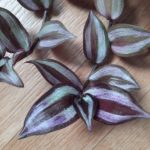
While propagating plants, always cut below the node. This way, when you propagate the cutting, the node will start growing roots. This works for both propagating in soil and propagating in water.
If you can’t find any nodes on the plant, you can cut below the freshest leaf for the same effect. Remember to remove the leaves by cutting them or twisting them off.
There shouldn’t be any leaves in the lower part of the stem that is buried in soil or submerged in water. If there are leaves on the lower part of the stem, they will start rotting during propagation and make the cutting unviable.
Can you propagate a Wandering Jew from a leaf?
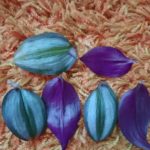
It is not technically impossible, but it has a very low success rate. It is quite unlikely that a leaf will grow into a new plant. Frankly, it is a lot more trouble than it is worth.
We suggest you try propagating with cuttings either in soil or in water. If you don’t want to spend too much effort, you can propagate your Wandering Jew in water. It doesn’t need any care till you transplant the cutting to a pot.
Urbane Jungle
In a world of towering brick and concrete edifices, sometimes one needs a little bit of plant life
Tradescantia: Wonderful Wanderers
02.07.2018 by rzr5355 // Leave a Comment

Solid, striped, or variegated; burgundy, emerald, lilac, and (sometimes or) white; and almost always pointed. The leaves of Tradescantia species come is a vast array of appearances and hues which dazzle the eye and draw many a plant-lover near. Now, these unique descriptions may cause you to believe that these lovely specimens are rare pieces of small gardening collections hoarded away from the eye of the general public; however, it is rather likely that you have encountered at least one cultivar of this ever-popular genus in your wanders through the wilds of your local gardening center.
All About Tradescantia
Known more widely as inch plant, spiderwort, or “wandering jew,” Tradescantia are a genus of around seventy-five perennial flowering plants native to the regions between Canada and mid-South America. The genus became more well-known during the 1600s, during which foreign trade introduced the prior unknown beauties to Europe. It was during this very same period that the genus’s popularity began to take root and, subsequently, these colorful, winding wonders trailed their way into the hearts of green thumbs and the environments of locales across the globe. This, unfortunately, has caused some species to become invasive and cause unrest in those ecosystems where it survives a little bit too successfully. (A kind thanks to Wikipedia for giving me the most quintessential knowledge I can’t seem to dig up on more “academic” sites!)
If you are anything like me, you are likely wonder why in the dickens these plants are known as “wandering jews.” Jackie Rhoades of Gardening Know How shares the story of the namesake in the post “ Growing Wandering Jew Houseplants .” Simply put, women of the home we quite adept at growing the plants and would share their clippings with one another, thereby allowing the houseplant to spread in a manner similar to that of historic members of the Jewish community.
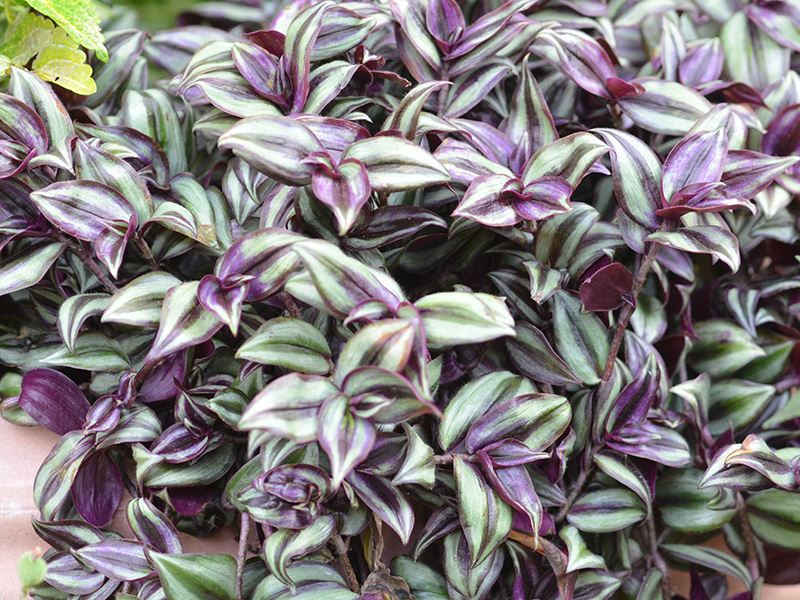
Tradescantia are widely known to be of insubstantial need; they are, in nature, wildflowers which trail and vine, after all. Despite the this self-preserving, low-maintenance facade, though, some small eccentricities have slightly swayed the genus’s total ease of care and necessitated a tidbit of attention on the part of jungle caregivers.
For Tradescantia , the most basic requirements, soil, is of equally basic need. Genus members grow best in a well-draining general purpose potting soil, but they can also do extremely well in soilless mediums as a result of their abilities to drain. Container size is not typically an issue and many cultivars can be placed in hanging baskets or pots one size up from their nursery pots to contain their growth.
One such peculiarity comes in relation to the watering preferences of the plants: they really don’t like wet feet and really, really don’t like to be watered at the base of their stems , known as the crown of the plant. At this point, you have probably heard my spiel about root rot and how plants (usually) don’t like to have water sitting in their containers; this also applies to Tradescantia . Beyond these small finicky pieces, the genus likes to be watered deeply, drained well, and misted to raise the surrounding humidity. During the dormant season (winter), watering should be reduced to accommodate for the plant’s growth stagnation, though.
Fertilization of the plant is not entirely necessary, but can be done up to twice monthly with a diluted solution of general-purpose houseplant fertilizer.
The sunlight and temperature requirements of Tradescantia are straightforward. All members of the genus prefer bright, indirect sunlight with the occasional glance of full exposure and all will grow steadily in temperatures ranging between 55 and 75 degrees Fahrenheit.
Unfortunately, Tradescantia are known be become elongated and “leggy” with time due to their trailing nature. Many growers, including The Spruce , suggest pinching the plant to encourage branching of the plant and ensure fullness. When the plant becomes too stretched, though, the issue can be addressed by taking plant cuttings, rooting them in water on a sunny window sill, and replanting when the new roots have grown to one inch in length. For more precise details about propagating, head over to SF Gate ‘s post on Wandering Jew Propagation !
Leave a Reply Cancel reply
Your email address will not be published. Required fields are marked *
Save my name, email, and website in this browser for the next time I comment.
How to Grow & Care for Nanouk Plant in Pots – Step by Step
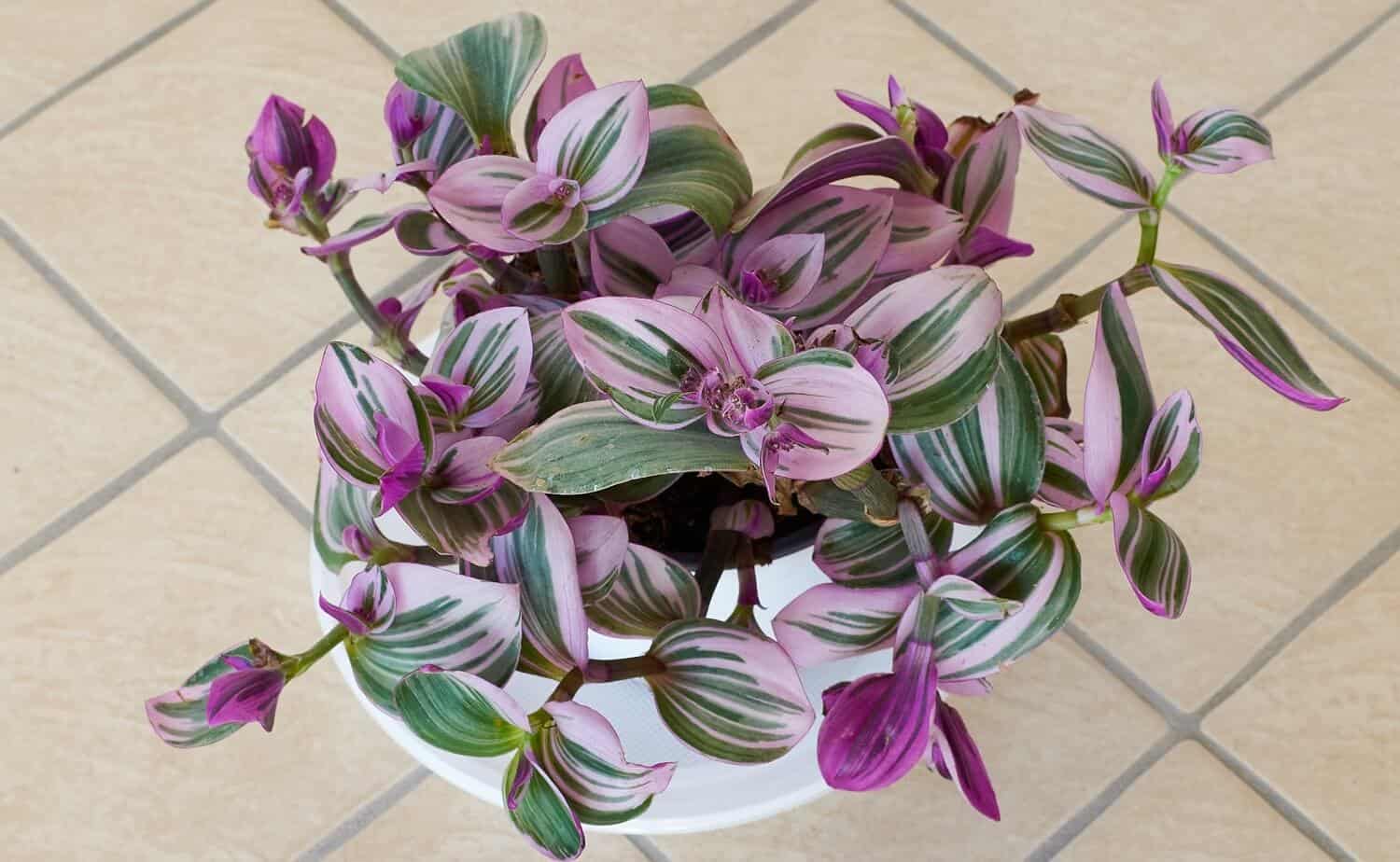
Sharing is caring!
If you’re familiar with the Nanouk plant, then you’d have discovered that it’s an easy-to-grow flowering succulent and a favorite of most plant lovers.
This plant is one of the easiest-to-care-for houseplants with minimal maintenance requirements. It has beautiful blue, pink-purple, or white flowers that grow from the pink buds and slightly fuzzy bright green, pink or purple foliage.
The Tradescantia Nanouk is a new cultivar developed in the Netherlands through a planned breeding program conducted in Sappemeer back in 2012.
The objective of this program was to create more compact Tradescantia plants with better performance and beautiful flower coloration.
And the objective was met!
So, if you are looking for a beautiful, low-maintenance trailing plant for hanging baskets , both indoors and outdoors, the Tradescantia Nanouk is the way to go!
If you want to know more about the pink Nanouk plant i.e. identification, propagation, care, and more. This article is meant for you! Read through and get to know your Tradescantia Nanouk plant well.
Let’s get started:
What’s Nanouk Plant
How to identify nanouk plant.
Tradescantia Nanouk is an herbaceous perennial cultivar in the Commelinaceae family. It’s mostly grown for its amazingly beautiful pink, bright green, and white lance-shaped foliage.
The stems of a Nanouk plant are thick and chunky to provide sturdy support to the rounded, fuzzy thick leaves.
It produces small, beautiful pink buds and white and yellow flowers in spring and summer. Tradescantia Nanouk branches grow upright but, with excellent growing conditions and some patience, this plant can trail.
Due to its beautiful and bright foliage, the Fantasy Venice enlivens spaces, especially when used in hanging baskets and as a ground cover.
That’s why it’s widely used as an indoor houseplant and also as a garden plant by a majority of plant lovers.
Noteworthy Characteristics (Plant Profile Summary)
Common name(s): Fantasy Venice, Tradescantia Nanouk, Nanouk Wandering Jew Plant or, Spiderwort 'Nanouk'.
Scientific/Botanical name: Tradescantia albiflora ‘Nanouk’ .
USDA Hardiness zones: 10 through 12 for outdoor growing.
Mature Height: Up to 0.5 feet tall.
Mature Spread: Up to 2 feet wide.
Growing habit: Compact and Upright to trailing plant habit.
Native Area: Mexico, South and Central America with cultivars developed in the Netherlands.
Blooming Time: Blooms throughout the plant’s growing season.
Invasive: Considered invasive in the State of Florida.
Toxicity: Toxic to cats, dogs, and humans.
Is Nanouk Plant Toxic?
Yes, just like all other Tradescantia varieties, the Tradescantia Nanouk plant is considered poisonous to both humans and pets.
The sap from this plant causes gastric distress if ingested and can be irritating to the skin.
Hence, keep your pets away and wash up immediately after handling your plant and/or use gloves.
Nanouk Plant Vs Wandering Jew
Nanouk plant and wandering Jew plant both belong to the same genus ‘Tradescantia’ and in general, require almost similar growing and care requirements.
They also have the same uses in the general landscape, container planting, interiorscape, indoor Plant and, hanging baskets.
However, if we look at their morphology, it’s possible to see a few distinctions between the two that will help you differentiate between them.
For instance; Tradescantia Nanouk plant has pink, bright green, and white lance-shaped foliage while Tradescantia Zebrina ‘green wandering Jew plant’ has variegated olive and silver foliage with purple undersides with purple on both sides for the ‘purple wandering Jew plant’
Apart from this, a Tradescantia Nanouk produces pink buds and white/yellow flowers while Tradescantia Wandering Jew produces white to lavender inconspicuous boat-shaped flowers.
Nanouk Plant Propagation
There are 2 methods of propagating a Nanouk plant. These include; plant division and stem cuttings.
In the stem cuttings method, you can root the cuttings either in water or, in soil. Let’s look at each method at a time.
Method 1: Nanouk plant propagation through division step by step
Step 1: Identify a mature, healthy plant free of pests and diseases. Then remove your plant from the pot carefully and remove all the soil from around the roots gently to avoid root damage.
Step 2: With a lot of care, separate each root ball and stem from one another. Sometimes, the roots of your Nanouk plant can be too intertwined to separate with bare hands without damaging them. If this is the case, use a pair of scissors to cut them apart (the scissors must be sterilized to avoid infections).
Step 3: Plant the individual baby plants in a well-draining potting mix in their containers. Ensure that the potting mix/soil remains moist but never soggy.
Step 4: Since after division the baby plants have some roots attached, it will take them a few more weeks for the roots to be fully established. Occasionally, pull your plants gently from the potting mix and feel if there’s some resistance or the plant just pulls off easily. Some resistance indicates that the roots are establishing and healthy.
Method 2: How to propagate a Nanouk plant in water step by step
Step 1: Identify a healthy Nanouk plant from which you’ll take the cuttings.
Step 2: Using a sterilized pair of scissors take the stem cuttings from the mother plant. Each of the stem cuttings you make must have at least a node (spots where the leaf attaches to the stem and where roots will form) and a leaf.
Step 3: Remove the lower-most leaves (if any) to leave a few inches of a bare stem.
Step 4: Put the cut end of the stem cutting into a jar or container of room-temperature freshwater such that at least a node is below the water surface. Ensure that there aren’t any leaves in the water.
Step 5: Place your container/jar in a warm location with bright, indirect light. Your cuttings need adequate light.
Step 6: Replace the water once every 5 to 7 days or when it gets grubby and top it up as soon as the level gets lower.
Step 7: It usually takes about a week for the tiny roots to sprout but, wait until the roots are about 2 to 3 inches long before you transfer the cuttings into soil. After you pot up your cutting water it properly and keep the potting mix/soil evenly moist.
Method 3: How to propagate a Nanouk plant in soil step by step
Step 4: Place the cut end of your stem cutting into a container of well-draining moistened potting mix/soil. Make sure that at least one node is under the surface and that all the leaves are above the surface. Maintain high humidity and keep the growing medium moist but not wet for healthy root development.
Step 5: Move the container with the cutting to a warm space with bright, indirect light.
Step 6: In a few weeks, your cutting will have established its roots and is ready to be treated like a normal plant.
Pro Tip: In all the cutting propagation methods, you can use a rooting hormone like Garden Safe rooting hormone to encourage roots to grow from the cuttings.
How to Grow & Care for Nanouk Plant in Pots – Step by Step
Step 1: selecting the appropriate potting soil.
The Nanouk plants are very resilient and easy to grow in moist, well-drained, and acidic (pH 5 to 6) soil. You just need a regular, well-draining houseplant potting mix/soil to pot your Tradescantia Nanouk and you’re good to go!
It’s always a good idea to add a handful of orchid bark, perlite or, horticultural/coarse sand to the potting mix to improve drainage .
You can also use a succulent-based potting mix to give your Nanouk plant plenty of drainage.
Pro Tip: Avoid dense soil as it holds too much water/moisture which might lead to root rot and plant death.
Step 2: The Best Planting Pots
When it comes to selecting the best planting pot for you Tradescantia Nanouk, keep in mind that this plant hates excessive moisture. It’s also a fast-grower.
Therefore, choose a pot that matches the size of your plant since you can repot whenever the need arises. (a pot that’s ½ inch larger than the plants’ current root ball is ideal).
A very large pot will cause more harm than good as it holds more soil, consequently more water which might lead to root rot. Also, the roots of this plant don’t need too much soil for sustainability.
The right amount of soil/potting mix ensures that the root ball soaks moisture fast and it’s not left to sit in soggy soil.
Step 3: Provide the Necessary Temperature & Humidity
Providing the right temperature for a Nanouk plant is easy as it performs just fine in a normal household temperature.
With daytime temperatures of up to 75 degrees Celsius and night temperatures of roughly mid-50s, you have nothing to worry about. Just avoid keeping the plant a windowsill as it might be exposed to drafts and cold.
Does a Nanouk plant like humidity?
Yes! This plant loves a humid environment of approximately 40-60%. So, place your Nanouk plant in a room or a more humid space. The lower the humidity levels, the drier the air gets and this leads to crispy leaves.
But the good thing is, you can easily create humidity for your plants whenever the levels are low.
For example, mist the plant more often, use a pebble tray filled with water or, place your plant near a humidifier.
I’d recommend the Pure Enrichment® MistAire™ Ultrasonic Cool Mist Humidifier from Amazon since it has a Quiet Operation, Automatic Shut-Off, Night Light Function and it’s affordable.
Alternatively, place your plant on the bathroom window where it enjoys the steam from your bath without being sprayed by the shower directly.
It’s also an excellent addition to your bathroom plants for a more luxurious look.
Step 4: Expose the Plants to Adequate Light
Tradescantia Nanouk plants love bright, indirect light for nice and brightly colored pink and purple leaves.
However, the light shouldn’t necessarily be natural light from the sun as you can still use grow lights to supplement the natural light.
Under low light, the leaves are smaller in size, and the color fades (more green and less variegated). Inadequate light also leads to a leggy plant. Placing your plants near a sunny window works well too in improving light availability.
Caution: Never place your plant in full sun to protect the leaves from scorching.
Step 5: Watering Your Nanouk Plants on a Need Basis
When it comes to watering, ‘ WHEN ’ to water is more crucial than ‘ HOW OFTEN’ you water this plant.
‘How often’ suggests a timeline or a schedule to follow. This means that at a specific time or date, you must water your Nanouk plant whether it needs watering or not.
This might lead to overwatering and subsequent root rot which results in a dull and unhealthy plant.
Therefore, check the moisture availability in the topsoil by sticking your index finger into the soil. If it feels dry, it’s the right time to water your Nanouk plant .
Alternatively, use a moisture meter to check if your plant needs watering or not. (That’s if you have one or, purchase a General Tools Digital Moisture Meter from Amazon should you wish to have one)
Usually, watering once a week is enough but there are a few factors that determine how often to water your Nanouk plant.
For instance; if yours is growing outdoors, it’s exposed to more heat and wind than the indoor-grown Nanouk hence, water it more frequently.
Also, when your Nanouk plant is actively growing i.e. in spring and summer, it takes up more water from the soil thus, requires to be watered more frequently than in winter when the plant is dormant.
In addition to this, the pot’s/container’s size also affects how often you water your plants. As such, plants in a small pot usually dry out faster than those in a larger one hence, water more frequently and vice versa.
If you still want to learn more about watering plants and especially succulents, read more on How to Properly Water Your Succulents .
Step 6: Fertilize your Nanouk Plants
Nanouk plants aren’t heavy feeders and usually do well even without feeding.
But, they benefit a lot from a monthly feed with houseplant fertilizer diluted to half the recommended strength when actively growing (in spring and summer).
However, be careful not to over-fertilize as this might lead to Nanouk leaf tips turning brown.
In addition to this, make sure to dampen the soil before applying fertilizer and follow the fertilizer application rates and schedule as instructed. This helps avoid plant burn from fertilizer.
Once the growing season is over, stop feeding your plants.
Caution: Do not fertilize your plants right after repotting; not until after 6 weeks to reduce the chances of burning the new root growth.
Other Common Problems in Tradescantia Nanouk
A leggy nanouk plant.
If your Nanouk plant shows signs of fewer leaves and long stretched-out branches, it’s a signal that the plant’s leggy.
Legginess in a Tradescantia Nanouk is caused by inadequate light. Like I earlier explained, always grow your Nanouk plant in bright, indirect light (either from sunlight or, grow light).
Even though this plant was bred for compact growth, it’s not always the case as you might find it a little bit leggy especially when it’s not compact enough.
To avoid having a leggy Tradescantia Nanouk plant, pinch off the leggy growth. This allows for new growth hence, a bushier plant.
You can also stick the cuttings you’ve made right back into the pot and allow them to root and Improve compactness.
Brown Leaf Tips in a Tradescantia Nanouk Plant
This is an indication that the humidity levels are lower than what the plant requires. Like I discussed earlier Tradescantia Nanouk is a humid-lover, and providing it with the right humidity levels is the only way to deal with this problem.
Apply the different ways of ensuring a constantly humid environment for your plant explained earlier in this article under ‘ Step 3: Provide the Necessary Temperature & Humidity
Nanouk Plant Leaf Patterns/variegation Fading
This is caused by too much light and if not controlled in time, the leaves will burn or discolor completely.
To manage how much light gets to your plant, move the plant away from direct sun rays and keep it at a spot with minimal sun rays both in the mornings and evenings.
Nanouk Leaves Curling/A dropping Nanouk Plant
The leaves of your Nanouk plant may curl either inwards or outwards due to moisture and light levels and this is usually accompanied by some discoloration.
Lack of enough moisture or dehydration as a result of too much light or not enough water causes the leaves to curl inwards to preserve the available moisture.
If the leaves are curling outwards, it’s an indication of too much water or not enough light.
The solution to this problem is to balance the light exposure and watering frequency. For clarity, you can refer to the light and watering requirements earlier discussed in this article ‘ Step 4: Expose the Plants to Adequate Light and Step 5: Watering Your Nanouk Plants on a Need Basis’
Like you have seen growing and caring for a Nanouk plant is easy provided you keep in mind its basic needs.
Whether you are a beginner or you’re used to houseplants, the information you just got will come in handy as you continue growing bountiful numbers of this plant.
And once you experience the striking dash of delight this plant brings to your household, I bet you’ll be addicted to it.
It’s time for you to give it a try.
Wishing you the best of luck with growing and caring for your Tradescantia Nanouk Plant!
National Parks Flora & Fauna Web
Tradescantia Nanouk Plant Invention

Free Ground Shipping on Orders Over $129*
*Some Exclusions May Apply
Call to Order! 844-348-8971
Home | Wandering Jew Plant
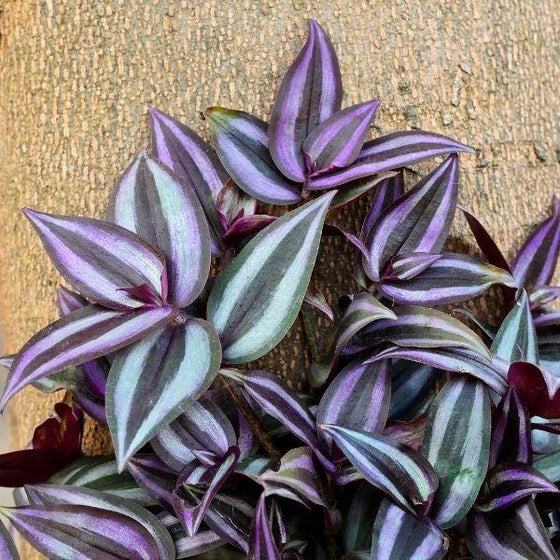
Images Depicted Range in Maturity & Container Size
Pots & Decorations Not Included Unless Otherwise Stated
Wandering Jew Plant
Tradescantia zebrina.
The Wandering Jew plant is a flowering house plant known for its striped eggplant-purple and lime green foliage. Typically grown as a houseplant, Tradescantia zebrina blooms freely throughout the year. This plant is not only beautiful, but flexible in all growing environments.
Shipping calculated at checkout.
Recommended Add-Ons
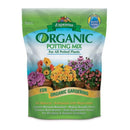
Espoma Organic Potting Mix
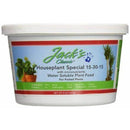
Jack's Classic Houseplant Special Fertilizer
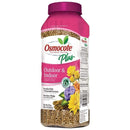
Osmocote Plus Outdoor and Indoor Plant Food
Wandering Jew Plants for Sale Online
The wandering Jew plant finds its way into hanging baskets and annual mixed containers for the summer because of its easy-going, tolerant nature. The vibrant purple and silver striped leaves bring personality to any space. This vine looks beautiful in hanging baskets or stands where its natural tendency to vine and trail is brought out. The undersides of the foliage and the stems are both reddish-purple. Wandering Jew is happiest with bright, indirect light to maintain its intense coloration. These plants prefer to dry out some between watering. The brightly colored purple and silver striped foliage blends well with virtually any other flower or foliage color.
The Wandering Jew plant looks great in a hanging basket or stands where it can show off its vining growth habit and unique foliage. Many consider this plant to be quite invasive when grown outdoors, but this quality makes it an excellent indoor vining plant. Grow this plant in bright, indirect sunlight for optimal vibrant blooms, and place it somewhere that’s not accessible to pets or small children.
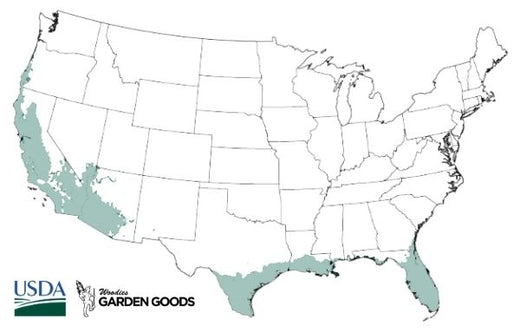
How to Care for Wandering Jew Plant
Before you buy a Wandering Jew plant, make sure to read about the care instructions that are required and recommended to keep this plant healthy and thriving.

What is the best light for Wandering Jew Plants?
Wandering Jew Plants need bright, indirect light from a windowsill. Place your plant in a north or east-facing window to help enhance its vibrant foliage. Outside, Wandering Jew Plants don't handle full sun very well. This plant prefers shade or part sun to maintain its variegated foliage. Too much light will burn the leaves.
How do I fertilize Wandering Jew Plants?
Any all purpose, foliage fertilizer will work for Wandering Jew Plants.Jack's Classic Indoor plant food works well as a powder, quick release fertilizer that is mixed with water to quickly provide nutrients to a plant that has been in a container for an extended time. Osmocote Indoor/Outdoor is an option as a granular, slow release fertilizer that can be applied while potting and planting.
How do I water variegated Wandering Jew Plants?
Wandering Jew Plants like to dry out occasionally between watering. It does not like to stay or sit in water or get too dry. Plants that are watered too often usually get crown rot, meaning the plant will die roots first. We recommend watering weekly during the summer, and less frequently in the winter.

What is the best soil for purple Wandering Jew Plants?
Wandering Jew Plants need a very well draining soil, and prefers to have slightly dry conditions. Regular potting mix with sand works well for plants potted in containers. Try to avoid an area with clay soil if planting outdoors to encourage better drainage.
Frequently Asked questions
How do you propagate wandering jew plants.
It is very simple to propagate a Wandering Jew plant. Cut a stem about 4 to 6 inches long with several leaves on it. Ideally, this should be one of the healthiest and strongest stems. Remove the leaves at the bottom of the stem, and place it in a jar of water. Make sure that there are not any leaves under the surface of the water, or they may rot. Change the water every couple of days to keep it clean. After a few weeks, the cutting should begin to root. Allow it to develop a couple of weeks longer before transferring to potting soil. After potting, give it a good, deep watering.
Is Wandering Jew toxic to cats?
According to the ASPCA, the Wandering Jew plant is toxic to dogs, cats, and horses. Contact with this plant can result in dermatitis, or skin irritation. It is important to take preventative precautions, or choose one of the many non-toxic plants we have available. Read our blog to find a list of pet-friendly houseplants!
How to prune Wandering Jew plants?
As its name suggests, the Wandering Jew plants grows long tendrils that can spread, or hang, depending on where the plant is placed. If you would rather keep the plant compact, you can trim off new growth and long stems. This can be done at any point in the year. In addition, it is important to remove dead or dying stems to maintain the plant's health and vigor.
Other Products you may be interested in
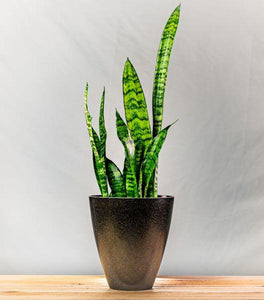
EcoForms 5.5 Inch Rice Hull Urn Planter
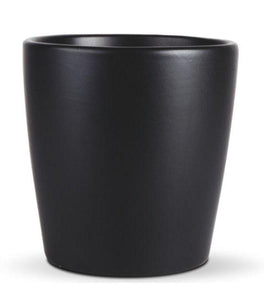
Ceramic Cylinder Plant Pot
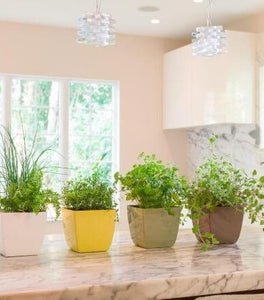
Crescent Kyle Square Resin Pot
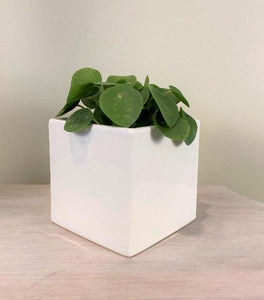
Square Ceramic Plant Pot
Customer Reviews

- Patio, Lawn & Garden
- Gardening & Lawn Care
- Plants, Seeds & Bulbs
Image Unavailable

- To view this video download Flash Player

Wandering Jew Lilac 3.5" Potted Plant - Tradescantia Fluminensis Lilac - Rare House Plant
Customers also viewed these products.

Product information
Looking for specific info, product description.
Listing is for 3.5" potted plant of Wandering Jew Lilac - Tradescantia Fluminensis Lilac - Rare House Plant Wandering Jew Rainbow is a spreading cascading plant with a rainbow of colorful foliage, the fleshy leaves are a mixture of white , green ,pink, mauve stripes and blotches. It gives small white flowers. Wandering jew plant care requires bright, indirect light. If the light is too dim, the leaf markings will fade. Keep the soil slightly moist, but don’t water directly into the crown as this will cause an unsightly rot in your wandering jew plant. Care should be taken, particularly in winter, that the plant doesn’t become too dry. Mist wandering jew plants frequently. Feed your plant monthly with a half-strength liquid fertilizer. An important part of growing wandering jew plants is pinching back the long, vining tendrils. Pinch back about a fourth of the plant to encourage branching and increase fullness. One of the main reasons for asking, “How do I care for my wandering jew?’ is the short life of the plant. Wandering jew houseplants do not age well. No matter how well your wandering jew plant care is, they lose their leaves at the base while the long legs keep growing. Don’t be surprised if your wandering jew plants need to be renewed once a year or so.
Customer reviews
Customer Reviews, including Product Star Ratings help customers to learn more about the product and decide whether it is the right product for them.
To calculate the overall star rating and percentage breakdown by star, we don’t use a simple average. Instead, our system considers things like how recent a review is and if the reviewer bought the item on Amazon. It also analyzed reviews to verify trustworthiness.
- Sort reviews by Top reviews Most recent Top reviews
Top reviews from the United States
There was a problem filtering reviews right now. please try again later..
- Amazon Newsletter
- About Amazon
- Accessibility
- Sustainability
- Press Center
- Investor Relations
- Amazon Devices
- Amazon Science
- Start Selling with Amazon
- Sell apps on Amazon
- Supply to Amazon
- Protect & Build Your Brand
- Become an Affiliate
- Become a Delivery Driver
- Start a Package Delivery Business
- Advertise Your Products
- Self-Publish with Us
- Host an Amazon Hub
- › See More Ways to Make Money
- Amazon Visa
- Amazon Store Card
- Amazon Secured Card
- Amazon Business Card
- Shop with Points
- Credit Card Marketplace
- Reload Your Balance
- Amazon Currency Converter
- Your Account
- Your Orders
- Shipping Rates & Policies
- Amazon Prime
- Returns & Replacements
- Manage Your Content and Devices
- Recalls and Product Safety Alerts
- Conditions of Use
- Privacy Notice
- Consumer Health Data Privacy Disclosure
- Your Ads Privacy Choices

IMAGES
VIDEO
COMMENTS
Tradescantia fluminensis Lilac grow and care - herbaceous of the genus Tradescantia also known as Wandering gypsy or Lilach Wandering jew plant, Tradescantia fluminensis Lilac perennial evergreen or annual in colder climate used as ornamental groundcover plant, can grow in mediterranean, desert, subtropics, temperate or tropics climate and growing in hardiness zone 9b+ as perennial and ...
Fill a 6-inch to 1-gallon container that drains with a rich, well-drained potting mix. Water the soil to settle it. Make about a 2-inch indentation in the soil where you want to place the Wandering Jew cutting. Remove the bottom leaves from the cutting where you will be inserting it into the soil.
Wandering jew propagation is easily done from stem cuttings from a mother plant. Remove all but a few leaves off of the stem cuttings and then place them in a smaller pot with moist potting soil in a warm, bright area. You'll start seeing new shoots growing after 1-1.5 months.
Wandering jew plants are super easy to propagate. Take cuttings that are 3-4″ long, and include a couple of leaf nodes. Dip the cut ends into rooting hormone, then stick them in moist soil. Don't allow the soil to dry out, and keep the air around the cuttings humid. A propagation chamber makes this simple.
W andering Jew Plant Care. To keep your Wandering Jew plant thriving, ensure it receives bright, indirect sunlight. Keep it in average room temperatures of 60-75°F (16-24°C). Fertilize once a month during spring and summer. In winter, relocate the plant to a cooler area with temperatures of 54-59°F (12-15°C).
Wandering Jew plants should be watered regularly to maintain a balanced moisture level in the soil. However, the soil should not be allowed to become too dry or too wet. Overwatering can lead to root rot. A good way to check if it's time to water is to push your finger about 1-inch into the soil.
The thick green leaves have a fuzzy texture and a purple hue on the underside. You can easily propagate it from the cuttings, both in soil and water, once it gets growing. It bears delightful clusters of blue, purple, white, or rose pink flowers, making it one of the best types of wandering jew plants on the list. 5. Tradescantia Sillamontana.
To care for a Wandering Jew plant indoors, place it in a location with bright, indirect sunlight, such as near a window. Water it when the top inch of soil feels dry, typically every 1-2 weeks, and provide well-draining soil. Additionally, mist the plant occasionally to increase humidity and remove dust from the leaves.
Wandering Jew (Tradescantia zebrina) is a trailing evergreen perennial in its native habitat (USDA hardiness zones 9 through 12). Where it's not winter hardy, wandering Jew is grown year-round as a houseplant. Are wandering Jew plants toxic to cats and dogs? Wandering Jew is not considered outright toxic, but it can cause some skin irritation.
"Nanouk" has a few other common names, such as Nanouk tradescantia, Fantasy Venice, Wandering Jew, Spiderwort, and Tradescantia bubblegum. This trendy plant was developed in the Netherlands in 2012 through a planned breeding program focused on creating a more compact type of Tradescantia with impressive flowers and highly dependable performance.
Tradescantia fluminensis is a perennial groundcover that spreads along the ground with soft, hairless stems and leaves. The fleshy stems root at any node that is on the surface. The plant has oval, dark-green leaves with pointed tips that are shiny, smooth and slightly fleshy about 1.25-2.5 inches (32-64 mm) long.
Tradescantia Nanouk Care. Tradescantia Nanouk needs bright indirect light to keep the vivid colors of its leaves, well-draining soil using orchid bark, perlite, and some horticultural sand to avoid root rot, and watering from below so that the leaves do not rot. Water every 2-3 weeks. The temperature should be within 60-75°F (16-24°C). A humidity level of 40-60% is ideal.
1.1 Step 1: Take Cuttings. 1.2 Step 2: Prepare the Pot. 1.3 Step 3: Aftercare. 2 How to Propagate Wandering Jew in Water. 2.1 Step 1: Get Cuttings. 2.2 Step 2: Prepare the Water. 2.3 Step 3: Aftercare. 3 When to Propagate Wandering Jew. 4 Wandering Jew Propagation Aftercare.
A Tradescantia zebrina quadricolor specimen as featured in Plant Rescue's post entitled "Tradescantia zebrina.". Solid, striped, or variegated; burgundy, emerald, lilac, and (sometimes or) white; and almost always pointed. The leaves of Tradescantia species come is a vast array of appearances and hues which dazzle the eye and draw many a plant-lover near.
Wandering Jew Lilac - Tradescantia Fluminensis Lilac - House Plant - 2.5 inch potted plant Wandering Jew Lilac is a spreading cascading plant with a rainbow of colorful foliage, the fleshy leaves are a mixture of white , green ,pink, mauve stripes and blotches. It gives small white flowers. Wandering jew plant care requires bright, indirect light.
Add to your landscape with this Wekiva Foliage Wandering Jew houseplant. It grows in bright, indirect sun. Green, heart-shaped leaves with purple stripes provide a silvery sheen. For more splashes of color, it offers small blooms with three petals that can be violet or white.
Apart from this, a Tradescantia Nanouk produces pink buds and white/yellow flowers while Tradescantia Wandering Jew produces white to lavender inconspicuous boat-shaped flowers. Nanouk Plant Propagation. There are 2 methods of propagating a Nanouk plant. These include; plant division and stem cuttings.
Find helpful customer reviews and review ratings for Wandering Jew Lilac - 2.5 inch Potted Plant - Tradescantia Fluminensis Lilac - House Plant at Amazon.com. Read honest and unbiased product reviews from our users.
6" Wandering Jew Tradescantia albiflora Tricolor Lilac Rainbow, FREE HEAT Pack, US Seller! (983) $39.99. Quality Rooted Purple Tradescantia Wandering Plant, Tradescantia zebrina. Rooted House Plants. Purple Tradescantia Plant | Live House Plant. (3.6k)
Tradescantia zebrina. The Wandering Jew plant is a flowering house plant known for its striped eggplant-purple and lime green foliage. Typically grown as a houseplant, Tradescantia zebrina blooms freely throughout the year. This plant is not only beautiful, but flexible in all growing environments. $12.95.
Listing is for one potted Wandering Jew Lilac Plant Tradescantia Fluminensis Lilac - Rare House Plant The pot is 2.5 x 3.5 and the plant is between 3 to 5 inches tall. There are about 4 to 5 growing stems in each pot.
Wandering Jew Tradescantia Nanouk Lilac Live Plant - Unique Houseplants for Easy Indoor Gardens & Home Decor Gifts - Potted Tiny Houseplants 4" inch White Pot Included 2.5 out of 5 stars 3 Pink Tradescantia Nanouk, Variegated Wandering Jew, Rare 2 inch Tiny Mini Pixie Plant
Listing is for 3.5" potted plant of Wandering Jew Lilac - Tradescantia Fluminensis Lilac - Rare House Plant Wandering Jew Rainbow is a spreading cascading plant with a rainbow of colorful foliage, the fleshy leaves are a mixture of white , green ,pink, mauve stripes and blotches. It gives small white flowers. Wandering jew plant care requires bright, indirect light. If the light is too dim ...